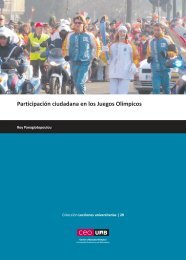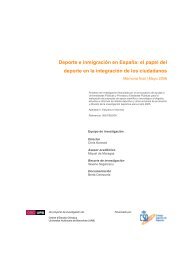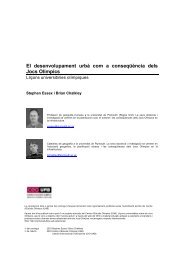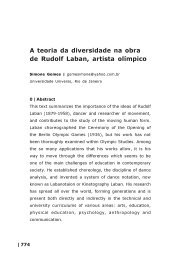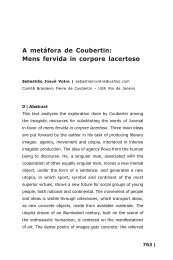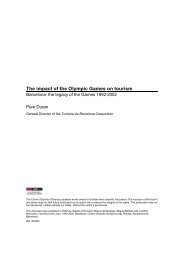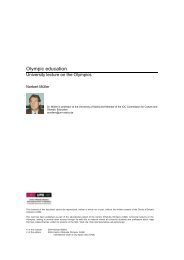Teaching Olympism in Schools: Olympic Education as a focus on ...
Teaching Olympism in Schools: Olympic Education as a focus on ...
Teaching Olympism in Schools: Olympic Education as a focus on ...
You also want an ePaper? Increase the reach of your titles
YUMPU automatically turns print PDFs into web optimized ePapers that Google loves.
<str<strong>on</strong>g>Teach<str<strong>on</strong>g>in</str<strong>on</strong>g>g</str<strong>on</strong>g> <str<strong>on</strong>g>Olympism</str<strong>on</strong>g> <str<strong>on</strong>g>in</str<strong>on</strong>g> <str<strong>on</strong>g>Schools</str<strong>on</strong>g>: <str<strong>on</strong>g>Olympic</str<strong>on</strong>g> <str<strong>on</strong>g>Educati<strong>on</strong></str<strong>on</strong>g> <str<strong>on</strong>g>as</str<strong>on</strong>g> a<br />
<str<strong>on</strong>g>focus</str<strong>on</strong>g> <strong>on</strong> Values <str<strong>on</strong>g>Educati<strong>on</strong></str<strong>on</strong>g><br />
University lectures <strong>on</strong> the <str<strong>on</strong>g>Olympic</str<strong>on</strong>g>s<br />
Deanna L. B<str<strong>on</strong>g>in</str<strong>on</strong>g>der<br />
Deanna L. B<str<strong>on</strong>g>in</str<strong>on</strong>g>der is Director of the Institute for <str<strong>on</strong>g>Olympic</str<strong>on</strong>g> <str<strong>on</strong>g>Educati<strong>on</strong></str<strong>on</strong>g> at the University of Alberta, Canada<br />
db<str<strong>on</strong>g>in</str<strong>on</strong>g>der@ualberta.ca<br />
The c<strong>on</strong>tents of this document cannot be reproduced, neither <str<strong>on</strong>g>in</str<strong>on</strong>g> whole nor <str<strong>on</strong>g>in</str<strong>on</strong>g> part, without the written c<strong>on</strong>sent of the Centre d’Estudis Olímpics (UAB).<br />
This text h<str<strong>on</strong>g>as</str<strong>on</strong>g> been published <str<strong>on</strong>g>as</str<strong>on</strong>g> part of the educati<strong>on</strong>al project of the Centre d’Estudis Olímpics (UAB), University lectures <strong>on</strong> the <str<strong>on</strong>g>Olympic</str<strong>on</strong>g>s, aim<str<strong>on</strong>g>in</str<strong>on</strong>g>g to<br />
provide open access through its web site to material aimed at university students and professors about major <str<strong>on</strong>g>Olympic</str<strong>on</strong>g>-related themes, written by experts<br />
<strong>on</strong> the field. Web site: http://olympicstudies.uab.es/lectures/<br />
© of the c<strong>on</strong>tent 2004 Deanna L. B<str<strong>on</strong>g>in</str<strong>on</strong>g>der<br />
© of the editi<strong>on</strong> 2005 Centre d’Estudis Olímpics (UAB)<br />
Internati<strong>on</strong>al Chair <str<strong>on</strong>g>in</str<strong>on</strong>g> <str<strong>on</strong>g>Olympism</str<strong>on</strong>g> (IOC-UAB)
To refer to this document, you can use the follow<str<strong>on</strong>g>in</str<strong>on</strong>g>g reference:<br />
© 2005 Centre d’Estudis Olímpics (UAB)<br />
Internati<strong>on</strong>al Chair In <str<strong>on</strong>g>Olympism</str<strong>on</strong>g> (IOC -UAB)<br />
Deanna l. B<str<strong>on</strong>g>in</str<strong>on</strong>g>der – <str<strong>on</strong>g>Teach<str<strong>on</strong>g>in</str<strong>on</strong>g>g</str<strong>on</strong>g> <str<strong>on</strong>g>Olympism</str<strong>on</strong>g> <str<strong>on</strong>g>in</str<strong>on</strong>g> schools<br />
B<str<strong>on</strong>g>in</str<strong>on</strong>g>der, Deanna L. (2005): <str<strong>on</strong>g>Teach<str<strong>on</strong>g>in</str<strong>on</strong>g>g</str<strong>on</strong>g> <str<strong>on</strong>g>Olympism</str<strong>on</strong>g> <str<strong>on</strong>g>in</str<strong>on</strong>g> schools: <str<strong>on</strong>g>Olympic</str<strong>on</strong>g> <str<strong>on</strong>g>Educati<strong>on</strong></str<strong>on</strong>g> <str<strong>on</strong>g>as</str<strong>on</strong>g> a <str<strong>on</strong>g>focus</str<strong>on</strong>g> <strong>on</strong> values educati<strong>on</strong>: university lectures <strong>on</strong> the <str<strong>on</strong>g>Olympic</str<strong>on</strong>g>s.<br />
Bellaterra : Centre d’Estudis Olímpics (UAB). Internati<strong>on</strong>al Chair <str<strong>on</strong>g>in</str<strong>on</strong>g> <str<strong>on</strong>g>Olympism</str<strong>on</strong>g> (IOC-UAB) [Date c<strong>on</strong>sulted: dd/mm/yy]<br />
<br />
[Date of publicati<strong>on</strong>: 2005]<br />
2
Summary<br />
© 2005 Centre d’Estudis Olímpics (UAB)<br />
Internati<strong>on</strong>al Chair In <str<strong>on</strong>g>Olympism</str<strong>on</strong>g> (IOC -UAB)<br />
Deanna l. B<str<strong>on</strong>g>in</str<strong>on</strong>g>der – <str<strong>on</strong>g>Teach<str<strong>on</strong>g>in</str<strong>on</strong>g>g</str<strong>on</strong>g> <str<strong>on</strong>g>Olympism</str<strong>on</strong>g> <str<strong>on</strong>g>in</str<strong>on</strong>g> schools<br />
1. Introducti<strong>on</strong> .................................................................................................... 5<br />
2. Orientati<strong>on</strong> for the reader .................................................................................................... 5<br />
3. Descripti<strong>on</strong>s of <str<strong>on</strong>g>Olympic</str<strong>on</strong>g> <str<strong>on</strong>g>Educati<strong>on</strong></str<strong>on</strong>g> ........................................................................................... 6<br />
4. <str<strong>on</strong>g>Teach<str<strong>on</strong>g>in</str<strong>on</strong>g>g</str<strong>on</strong>g> <str<strong>on</strong>g>Olympic</str<strong>on</strong>g> Values .................................................................................................... 9<br />
4.1. Martha Nussbaum .................................................................................................... 10<br />
4.2. Carol Gilligan .................................................................................................... 11<br />
4.3. Nel Nodd<str<strong>on</strong>g>in</str<strong>on</strong>g>gs .................................................................................................... 12<br />
4.4. Max<str<strong>on</strong>g>in</str<strong>on</strong>g>e Greene .................................................................................................... 13<br />
5. C<strong>on</strong>clusi<strong>on</strong>s .................................................................................................... 14<br />
Bibliographical references .................................................................................................... 16<br />
3
© 2005 Centre d’Estudis Olímpics (UAB)<br />
Internati<strong>on</strong>al Chair In <str<strong>on</strong>g>Olympism</str<strong>on</strong>g> (IOC -UAB)<br />
Deanna l. B<str<strong>on</strong>g>in</str<strong>on</strong>g>der – <str<strong>on</strong>g>Teach<str<strong>on</strong>g>in</str<strong>on</strong>g>g</str<strong>on</strong>g> <str<strong>on</strong>g>Olympism</str<strong>on</strong>g> <str<strong>on</strong>g>in</str<strong>on</strong>g> schools<br />
4
1. Introducti<strong>on</strong><br />
© 2005 Centre d’Estudis Olímpics (UAB)<br />
Internati<strong>on</strong>al Chair In <str<strong>on</strong>g>Olympism</str<strong>on</strong>g> (IOC -UAB)<br />
Deanna l. B<str<strong>on</strong>g>in</str<strong>on</strong>g>der – <str<strong>on</strong>g>Teach<str<strong>on</strong>g>in</str<strong>on</strong>g>g</str<strong>on</strong>g> <str<strong>on</strong>g>Olympism</str<strong>on</strong>g> <str<strong>on</strong>g>in</str<strong>on</strong>g> schools<br />
Fundamental to the understand<str<strong>on</strong>g>in</str<strong>on</strong>g>g of <str<strong>on</strong>g>Olympism</str<strong>on</strong>g> is its emph<str<strong>on</strong>g>as</str<strong>on</strong>g>is <strong>on</strong> an educati<strong>on</strong>al mandate. In fact, the “<str<strong>on</strong>g>Olympic</str<strong>on</strong>g><br />
idea cannot be understood without an understand<str<strong>on</strong>g>in</str<strong>on</strong>g>g of its educati<strong>on</strong>al missi<strong>on</strong>” (Gessman, 1992:33). This<br />
educati<strong>on</strong>al mandate is outl<str<strong>on</strong>g>in</str<strong>on</strong>g>ed <str<strong>on</strong>g>in</str<strong>on</strong>g> several of the Fundamental Pr<str<strong>on</strong>g>in</str<strong>on</strong>g>ciples of the <str<strong>on</strong>g>Olympic</str<strong>on</strong>g> Charter (IOC: 2000).<br />
Fundamental Pr<str<strong>on</strong>g>in</str<strong>on</strong>g>ciple #2 – <str<strong>on</strong>g>Olympism</str<strong>on</strong>g> is a philosophy of life; exalt<str<strong>on</strong>g>in</str<strong>on</strong>g>g and comb<str<strong>on</strong>g>in</str<strong>on</strong>g><str<strong>on</strong>g>in</str<strong>on</strong>g>g <str<strong>on</strong>g>in</str<strong>on</strong>g> a balanced whole<br />
the qualities of body, will and m<str<strong>on</strong>g>in</str<strong>on</strong>g>d. Blend<str<strong>on</strong>g>in</str<strong>on</strong>g>g sport with culture and educati<strong>on</strong>, <str<strong>on</strong>g>Olympism</str<strong>on</strong>g> seeks to create a<br />
way of life b<str<strong>on</strong>g>as</str<strong>on</strong>g>ed <strong>on</strong> the joy found <str<strong>on</strong>g>in</str<strong>on</strong>g> effort, the educati<strong>on</strong>al value of good example and respect for<br />
universal fundamental ethical pr<str<strong>on</strong>g>in</str<strong>on</strong>g>ciples.<br />
Fundamental Pr<str<strong>on</strong>g>in</str<strong>on</strong>g>ciple #3 – The goal of <str<strong>on</strong>g>Olympism</str<strong>on</strong>g> is to place everywhere sport at the service of the<br />
harm<strong>on</strong>ious development of man, with a view to encourag<str<strong>on</strong>g>in</str<strong>on</strong>g>g the establishment of a peaceful society<br />
c<strong>on</strong>cerned with the preservati<strong>on</strong> of human dignity.<br />
This is a values educati<strong>on</strong> mandate. Some of the specific positive values referred to <str<strong>on</strong>g>in</str<strong>on</strong>g> these pr<str<strong>on</strong>g>in</str<strong>on</strong>g>ciples <str<strong>on</strong>g>in</str<strong>on</strong>g>clude a<br />
respect for balance <str<strong>on</strong>g>in</str<strong>on</strong>g> the human character between <str<strong>on</strong>g>as</str<strong>on</strong>g>pects of m<str<strong>on</strong>g>in</str<strong>on</strong>g>d, body and spirit, an understand<str<strong>on</strong>g>in</str<strong>on</strong>g>g of the joy<br />
found <str<strong>on</strong>g>in</str<strong>on</strong>g> effort, an emph<str<strong>on</strong>g>as</str<strong>on</strong>g>is <strong>on</strong> peaceful behaviour, and respect for others (here described <str<strong>on</strong>g>as</str<strong>on</strong>g> preservati<strong>on</strong> of<br />
human dignity). The pr<str<strong>on</strong>g>in</str<strong>on</strong>g>ciples, while somewhat awkward <str<strong>on</strong>g>in</str<strong>on</strong>g> their English word<str<strong>on</strong>g>in</str<strong>on</strong>g>g, also <str<strong>on</strong>g>in</str<strong>on</strong>g>clude directi<strong>on</strong> for an<br />
<str<strong>on</strong>g>Olympic</str<strong>on</strong>g> pedagogy. That is, the fundamental pr<str<strong>on</strong>g>in</str<strong>on</strong>g>ciples seem to suggest comp<strong>on</strong>ents of a possible teach<str<strong>on</strong>g>in</str<strong>on</strong>g>g and<br />
learn<str<strong>on</strong>g>in</str<strong>on</strong>g>g strategy. Note the references to such strategies <str<strong>on</strong>g>as</str<strong>on</strong>g> “blend<str<strong>on</strong>g>in</str<strong>on</strong>g>g sport with culture and educati<strong>on</strong>,” sett<str<strong>on</strong>g>in</str<strong>on</strong>g>g<br />
“good examples,” and encourag<str<strong>on</strong>g>in</str<strong>on</strong>g>g participati<strong>on</strong> <str<strong>on</strong>g>in</str<strong>on</strong>g> sport <str<strong>on</strong>g>as</str<strong>on</strong>g> an educati<strong>on</strong>al situati<strong>on</strong> <str<strong>on</strong>g>in</str<strong>on</strong>g> which these values can be<br />
developed.<br />
S<str<strong>on</strong>g>in</str<strong>on</strong>g>ce the 1970s, there have been many versi<strong>on</strong>s of what <str<strong>on</strong>g>Olympic</str<strong>on</strong>g> educati<strong>on</strong> means, and many descripti<strong>on</strong>s of<br />
the orientati<strong>on</strong> and c<strong>on</strong>tents of an <str<strong>on</strong>g>Olympic</str<strong>on</strong>g> educati<strong>on</strong> program. Dr. Norbert Mueller’s lecture <strong>on</strong> the <str<strong>on</strong>g>Olympic</str<strong>on</strong>g><br />
educati<strong>on</strong> orientati<strong>on</strong> of Pierre de Coubert<str<strong>on</strong>g>in</str<strong>on</strong>g>, which is located <str<strong>on</strong>g>in</str<strong>on</strong>g> this series of lectures <strong>on</strong> the Aut<strong>on</strong>omous<br />
University of Barcel<strong>on</strong>a’s web site, is an example. Several other descripti<strong>on</strong>s of <str<strong>on</strong>g>Olympic</str<strong>on</strong>g> educati<strong>on</strong> are described<br />
<str<strong>on</strong>g>in</str<strong>on</strong>g> the discussi<strong>on</strong> that follows here.<br />
The present lecture’s ma<str<strong>on</strong>g>in</str<strong>on</strong>g> <str<strong>on</strong>g>focus</str<strong>on</strong>g>, however, is <strong>on</strong> “how” teachers, coaches, and professors can help young<br />
people develop values <str<strong>on</strong>g>as</str<strong>on</strong>g>sociated with the c<strong>on</strong>cept of <str<strong>on</strong>g>Olympism</str<strong>on</strong>g>. In the process of explor<str<strong>on</strong>g>in</str<strong>on</strong>g>g pedagogical<br />
strategies that are necessary to or seem to facilitate the development of and the re<str<strong>on</strong>g>in</str<strong>on</strong>g>forcement of positive values<br />
and behaviours, reference will be made to current curriculum literature <str<strong>on</strong>g>in</str<strong>on</strong>g> the general field of values educati<strong>on</strong>,<br />
and also to literature <strong>on</strong> the topic of values development with<str<strong>on</strong>g>in</str<strong>on</strong>g> sport educati<strong>on</strong> and physical educati<strong>on</strong> programs.<br />
The lecture will then <str<strong>on</strong>g>in</str<strong>on</strong>g>troduce issues and c<strong>on</strong>cerns with respect to the teach<str<strong>on</strong>g>in</str<strong>on</strong>g>g of four core educati<strong>on</strong>al values<br />
identified <str<strong>on</strong>g>in</str<strong>on</strong>g> an <str<strong>on</strong>g>in</str<strong>on</strong>g>ternati<strong>on</strong>al <str<strong>on</strong>g>Olympic</str<strong>on</strong>g> educati<strong>on</strong> project <str<strong>on</strong>g>as</str<strong>on</strong>g> be<str<strong>on</strong>g>in</str<strong>on</strong>g>g closely related to the c<strong>on</strong>cept of <str<strong>on</strong>g>Olympism</str<strong>on</strong>g>: joy of<br />
endeavour <str<strong>on</strong>g>in</str<strong>on</strong>g> physical activity, fair play, multiculturalism (<str<strong>on</strong>g>in</str<strong>on</strong>g>ternati<strong>on</strong>al understand<str<strong>on</strong>g>in</str<strong>on</strong>g>g) and be<str<strong>on</strong>g>in</str<strong>on</strong>g>g the best that you<br />
can be (pursuit of excellence). It will c<strong>on</strong>clude by discuss<str<strong>on</strong>g>in</str<strong>on</strong>g>g the complexities of try<str<strong>on</strong>g>in</str<strong>on</strong>g>g to me<str<strong>on</strong>g>as</str<strong>on</strong>g>ure changes <str<strong>on</strong>g>in</str<strong>on</strong>g><br />
values and behaviours <str<strong>on</strong>g>as</str<strong>on</strong>g> a result of an <str<strong>on</strong>g>Olympic</str<strong>on</strong>g> educati<strong>on</strong> <str<strong>on</strong>g>in</str<strong>on</strong>g>te rventi<strong>on</strong>.<br />
2. Orientati<strong>on</strong> for the reader<br />
It is hoped that this lecture will <str<strong>on</strong>g>in</str<strong>on</strong>g>augurate a worldwide discussi<strong>on</strong> <strong>on</strong> the topic of <str<strong>on</strong>g>Olympic</str<strong>on</strong>g> pedagogy. In a post-<br />
modern milieu is it even th<str<strong>on</strong>g>in</str<strong>on</strong>g>kable to speak about “universal fundamental ethical pr<str<strong>on</strong>g>in</str<strong>on</strong>g>ciples” <str<strong>on</strong>g>as</str<strong>on</strong>g> the <str<strong>on</strong>g>Olympic</str<strong>on</strong>g><br />
Charter does? It is true that ethical issues such <str<strong>on</strong>g>as</str<strong>on</strong>g> fair play, violence, cheat<str<strong>on</strong>g>in</str<strong>on</strong>g>g, abuse of performance enhanc<str<strong>on</strong>g>in</str<strong>on</strong>g>g<br />
5
© 2005 Centre d’Estudis Olímpics (UAB)<br />
Internati<strong>on</strong>al Chair In <str<strong>on</strong>g>Olympism</str<strong>on</strong>g> (IOC -UAB)<br />
Deanna l. B<str<strong>on</strong>g>in</str<strong>on</strong>g>der – <str<strong>on</strong>g>Teach<str<strong>on</strong>g>in</str<strong>on</strong>g>g</str<strong>on</strong>g> <str<strong>on</strong>g>Olympism</str<strong>on</strong>g> <str<strong>on</strong>g>in</str<strong>on</strong>g> schools<br />
drugs, commercialism, equity, etc. receive much media attenti<strong>on</strong> and are frequently addressed <str<strong>on</strong>g>in</str<strong>on</strong>g> papers and<br />
presentati<strong>on</strong>s at <str<strong>on</strong>g>Olympic</str<strong>on</strong>g> sport and physical educati<strong>on</strong> c<strong>on</strong>ferences. They seem to have worldwide relevance.<br />
Unfortunately the pedagogy of these issues is rarely addressed. How are fair play/ethical behaviours learned?<br />
How can they be taught, and how can this teach<str<strong>on</strong>g>in</str<strong>on</strong>g>g be supported? The literature also appears silent <strong>on</strong> the cross-<br />
cultural issues. How, for example, is fair play understood and experienced by people <str<strong>on</strong>g>in</str<strong>on</strong>g> different cultural c<strong>on</strong>texts?<br />
Educators, like all people, are products of their own cultural, political and educati<strong>on</strong>al milieaux. They see the world<br />
through the filters of their particular educati<strong>on</strong>al and systemic orientati<strong>on</strong>s. Hans Georg Gadamer (1989)<br />
describes this filter <str<strong>on</strong>g>as</str<strong>on</strong>g> a “horiz<strong>on</strong>” def<str<strong>on</strong>g>in</str<strong>on</strong>g><str<strong>on</strong>g>in</str<strong>on</strong>g>g the boundaries of understand<str<strong>on</strong>g>in</str<strong>on</strong>g>g between people. Thus, for example,<br />
this lectu re is somewhat def<str<strong>on</strong>g>in</str<strong>on</strong>g>ed or boundaried by its dependence <strong>on</strong> Euro-American understand<str<strong>on</strong>g>in</str<strong>on</strong>g>gs (literature)<br />
available <str<strong>on</strong>g>in</str<strong>on</strong>g> English. It is also somewhat boundaried by the North -American, specifically Canadian, orientati<strong>on</strong> of<br />
its author to schools, educati<strong>on</strong>al systems and curriculum.<br />
Hopefully, this does not mean that the understand<str<strong>on</strong>g>in</str<strong>on</strong>g>g and <str<strong>on</strong>g>in</str<strong>on</strong>g>sights of the author of this lecture do not have<br />
mean<str<strong>on</strong>g>in</str<strong>on</strong>g>g and relevance for people <str<strong>on</strong>g>in</str<strong>on</strong>g> other educati<strong>on</strong>al circumstances. Rather, it means that readers (each with<br />
his or her own “horiz<strong>on</strong>”) should approach this lecture with a reflective orientati<strong>on</strong>, engag<str<strong>on</strong>g>in</str<strong>on</strong>g>g the author <str<strong>on</strong>g>in</str<strong>on</strong>g> a silent<br />
dialogue, and reflect<str<strong>on</strong>g>in</str<strong>on</strong>g>g <strong>on</strong> questi<strong>on</strong>s such <str<strong>on</strong>g>as</str<strong>on</strong>g>:<br />
1. Do the values that are described here have the same mean<str<strong>on</strong>g>in</str<strong>on</strong>g>g for me and for people <str<strong>on</strong>g>in</str<strong>on</strong>g> my cultural and<br />
educati<strong>on</strong>al lifeworld <str<strong>on</strong>g>as</str<strong>on</strong>g> they seem to have for the author? How are each of the values different? How are<br />
they the same?<br />
2. What comp<strong>on</strong>ents of an <str<strong>on</strong>g>Olympic</str<strong>on</strong>g> educati<strong>on</strong> program would <str<strong>on</strong>g>in</str<strong>on</strong>g>tegrate well with educati<strong>on</strong>al priorities and the<br />
value systems <str<strong>on</strong>g>in</str<strong>on</strong>g> my country? What comp<strong>on</strong>ents might not be welcomed? Why?<br />
3. Do I understand the educati<strong>on</strong>al pr<str<strong>on</strong>g>in</str<strong>on</strong>g>ciples outl<str<strong>on</strong>g>in</str<strong>on</strong>g>ed <str<strong>on</strong>g>in</str<strong>on</strong>g> this lecture for teach<str<strong>on</strong>g>in</str<strong>on</strong>g>g <str<strong>on</strong>g>Olympic</str<strong>on</strong>g> values? Will they have<br />
relevance <str<strong>on</strong>g>in</str<strong>on</strong>g> the educati<strong>on</strong>al and cultural circumstances <str<strong>on</strong>g>in</str<strong>on</strong>g> which I work? Why or why not?<br />
4. What teach<str<strong>on</strong>g>in</str<strong>on</strong>g>g and learn<str<strong>on</strong>g>in</str<strong>on</strong>g>g strategies could I suggest to enhance the teach<str<strong>on</strong>g>in</str<strong>on</strong>g>g of <str<strong>on</strong>g>Olympism</str<strong>on</strong>g> <str<strong>on</strong>g>in</str<strong>on</strong>g> the schools <str<strong>on</strong>g>in</str<strong>on</strong>g><br />
my country?<br />
Hopefully, <str<strong>on</strong>g>in</str<strong>on</strong>g> the not too distant future, a silent dialogue, such <str<strong>on</strong>g>as</str<strong>on</strong>g> the <strong>on</strong>e recommended for a read<str<strong>on</strong>g>in</str<strong>on</strong>g>g of this<br />
lecture, could become an <str<strong>on</strong>g>in</str<strong>on</strong>g>ternati<strong>on</strong>al exchange of ide<str<strong>on</strong>g>as</str<strong>on</strong>g> through <str<strong>on</strong>g>in</str<strong>on</strong>g>ternet discussi<strong>on</strong>s, a c<strong>on</strong>ference or a series<br />
of workshops.<br />
3. Descripti<strong>on</strong>s of <str<strong>on</strong>g>Olympic</str<strong>on</strong>g> <str<strong>on</strong>g>Educati<strong>on</strong></str<strong>on</strong>g><br />
S<str<strong>on</strong>g>in</str<strong>on</strong>g>ce the 1970s, <str<strong>on</strong>g>Olympic</str<strong>on</strong>g> scholars have c<strong>on</strong>t<str<strong>on</strong>g>in</str<strong>on</strong>g>ued to rework the pedagogical ide<str<strong>on</strong>g>as</str<strong>on</strong>g> of <str<strong>on</strong>g>Olympism</str<strong>on</strong>g>. For Gessman,<br />
(1992) the core of the <str<strong>on</strong>g>Olympic</str<strong>on</strong>g> value system is the steady development of the potential of every human be<str<strong>on</strong>g>in</str<strong>on</strong>g>g. His<br />
emph<str<strong>on</strong>g>as</str<strong>on</strong>g>is is <strong>on</strong> school sport, and he outl<str<strong>on</strong>g>in</str<strong>on</strong>g>es suggested learn<str<strong>on</strong>g>in</str<strong>on</strong>g>g are<str<strong>on</strong>g>as</str<strong>on</strong>g> that would be c<strong>on</strong>nected to school sport<br />
(practice, tra<str<strong>on</strong>g>in</str<strong>on</strong>g><str<strong>on</strong>g>in</str<strong>on</strong>g>g, competiti<strong>on</strong>s) carried out <str<strong>on</strong>g>in</str<strong>on</strong>g> corresp<strong>on</strong>dence with the <str<strong>on</strong>g>Olympic</str<strong>on</strong>g> idea. These learn<str<strong>on</strong>g>in</str<strong>on</strong>g>g are<str<strong>on</strong>g>as</str<strong>on</strong>g><br />
<str<strong>on</strong>g>in</str<strong>on</strong>g>clude: fair play, health, risk-tak<str<strong>on</strong>g>in</str<strong>on</strong>g>g and adventure, artistic and creative development, and sociability (p. 38).<br />
Bruce Kidd (1985) articulated the follow<str<strong>on</strong>g>in</str<strong>on</strong>g>g po<str<strong>on</strong>g>in</str<strong>on</strong>g>ts of corresp<strong>on</strong>dence between <str<strong>on</strong>g>Olympism</str<strong>on</strong>g> and general goals of<br />
educati<strong>on</strong> (p. 10):<br />
6
© 2005 Centre d’Estudis Olímpics (UAB)<br />
Internati<strong>on</strong>al Chair In <str<strong>on</strong>g>Olympism</str<strong>on</strong>g> (IOC -UAB)<br />
Deanna l. B<str<strong>on</strong>g>in</str<strong>on</strong>g>der – <str<strong>on</strong>g>Teach<str<strong>on</strong>g>in</str<strong>on</strong>g>g</str<strong>on</strong>g> <str<strong>on</strong>g>Olympism</str<strong>on</strong>g> <str<strong>on</strong>g>in</str<strong>on</strong>g> schools<br />
� M<str<strong>on</strong>g>as</str<strong>on</strong>g>s Participati<strong>on</strong>: the expansi<strong>on</strong> of opportunities for sport and play to create what de Coubert<str<strong>on</strong>g>in</str<strong>on</strong>g> called<br />
“the democracy of youth”;<br />
� Sport <str<strong>on</strong>g>as</str<strong>on</strong>g> <str<strong>on</strong>g>Educati<strong>on</strong></str<strong>on</strong>g>: the development of opportunities that are genu<str<strong>on</strong>g>in</str<strong>on</strong>g>ely educati<strong>on</strong>al, that <str<strong>on</strong>g>as</str<strong>on</strong>g>sist both<br />
<str<strong>on</strong>g>in</str<strong>on</strong>g>dividuals and groups <str<strong>on</strong>g>in</str<strong>on</strong>g> the process of knowledge;<br />
� Sportsmanship: the foster<str<strong>on</strong>g>in</str<strong>on</strong>g>g of a high standard of sportsmanship, that de Coubert<str<strong>on</strong>g>in</str<strong>on</strong>g> called “the new code<br />
of chivalry”.<br />
� Cultural Exchange: the <str<strong>on</strong>g>in</str<strong>on</strong>g>tegrati<strong>on</strong> of the visual and perform<str<strong>on</strong>g>in</str<strong>on</strong>g>g arts <str<strong>on</strong>g>in</str<strong>on</strong>g>to the <str<strong>on</strong>g>Olympic</str<strong>on</strong>g> celebrati<strong>on</strong>s;<br />
� Internati<strong>on</strong>al Understand<str<strong>on</strong>g>in</str<strong>on</strong>g>g: the creati<strong>on</strong> of a movement whose membership transcends racial, religious,<br />
political and ec<strong>on</strong>omic categories, a brotherhood that promotes understand<str<strong>on</strong>g>in</str<strong>on</strong>g>g and thus c<strong>on</strong>tributes to<br />
world peace; and<br />
� Excellence: the pursuit of excellence <str<strong>on</strong>g>in</str<strong>on</strong>g> performance.<br />
In Germany, Gruepe (1996) distilled three ma<str<strong>on</strong>g>in</str<strong>on</strong>g> pedagogical messages out of de Coubert<str<strong>on</strong>g>in</str<strong>on</strong>g>’s writ<str<strong>on</strong>g>in</str<strong>on</strong>g>gs <strong>on</strong><br />
educati<strong>on</strong>: 1) development of body, m<str<strong>on</strong>g>in</str<strong>on</strong>g>d and character through a striv<str<strong>on</strong>g>in</str<strong>on</strong>g>g for achievement <str<strong>on</strong>g>in</str<strong>on</strong>g> physical e ndeavours<br />
and competiti<strong>on</strong> (carried out always <str<strong>on</strong>g>in</str<strong>on</strong>g> the spirit of fair play), 2) availability of a wide variety of sports, and 3)<br />
peace, friendl<str<strong>on</strong>g>in</str<strong>on</strong>g>ess and <str<strong>on</strong>g>in</str<strong>on</strong>g>ternati<strong>on</strong>al understand<str<strong>on</strong>g>in</str<strong>on</strong>g>g.<br />
Mueller (2004), <str<strong>on</strong>g>in</str<strong>on</strong>g> his recent lecture <strong>on</strong> <str<strong>on</strong>g>Olympic</str<strong>on</strong>g> <str<strong>on</strong>g>Educati<strong>on</strong></str<strong>on</strong>g> offers a descripti<strong>on</strong> of the <str<strong>on</strong>g>Olympic</str<strong>on</strong>g> educati<strong>on</strong> ide<str<strong>on</strong>g>as</str<strong>on</strong>g> that<br />
evolved <str<strong>on</strong>g>in</str<strong>on</strong>g> the life and writ<str<strong>on</strong>g>in</str<strong>on</strong>g>gs of Pierre de Coubert<str<strong>on</strong>g>in</str<strong>on</strong>g>. He describes the “features of an ‘<str<strong>on</strong>g>Olympic</str<strong>on</strong>g> educati<strong>on</strong>, all of<br />
which can be traced back to Coubert<str<strong>on</strong>g>in</str<strong>on</strong>g>’s philosophical legacy:”<br />
� the c<strong>on</strong>cept of harm<strong>on</strong>ious development of the whole human be<str<strong>on</strong>g>in</str<strong>on</strong>g>g<br />
� the idea of striv<str<strong>on</strong>g>in</str<strong>on</strong>g>g for human perfecti<strong>on</strong> through high performance [scientific and artistic <str<strong>on</strong>g>as</str<strong>on</strong>g> well <str<strong>on</strong>g>as</str<strong>on</strong>g> sport<str<strong>on</strong>g>in</str<strong>on</strong>g>g]<br />
� sport<str<strong>on</strong>g>in</str<strong>on</strong>g>g activity voluntarily l<str<strong>on</strong>g>in</str<strong>on</strong>g>ked to ethical pr<str<strong>on</strong>g>in</str<strong>on</strong>g>ciples such <str<strong>on</strong>g>as</str<strong>on</strong>g> fair play and equality of opportunity<br />
� the c<strong>on</strong>cept of peace and goodwill between nati<strong>on</strong>s, reflected by respect and tolerance <str<strong>on</strong>g>in</str<strong>on</strong>g> relati<strong>on</strong>s between<br />
<str<strong>on</strong>g>in</str<strong>on</strong>g>dividuals<br />
� the promoti<strong>on</strong> of moves towards emancipati<strong>on</strong> <str<strong>on</strong>g>in</str<strong>on</strong>g> and through sport.<br />
Readers will recognize the similarities and cross-overs <str<strong>on</strong>g>in</str<strong>on</strong>g> these various <str<strong>on</strong>g>in</str<strong>on</strong>g>terpretati<strong>on</strong>s of <str<strong>on</strong>g>Olympic</str<strong>on</strong>g> educati<strong>on</strong>.<br />
Each, however, h<str<strong>on</strong>g>as</str<strong>on</strong>g> its own particular emph<str<strong>on</strong>g>as</str<strong>on</strong>g>is. In a white paper for the German Rhe<str<strong>on</strong>g>in</str<strong>on</strong>g>-Ruhr bid committee for<br />
the 2012 <str<strong>on</strong>g>Olympic</str<strong>on</strong>g> Games, Naul (2002) notes that although there seems to be agreement <strong>on</strong> the general didactic<br />
standards that need to exist for a program to be described <str<strong>on</strong>g>as</str<strong>on</strong>g> “<str<strong>on</strong>g>Olympic</str<strong>on</strong>g> educati<strong>on</strong>” (p. B11) there are major<br />
differences <str<strong>on</strong>g>in</str<strong>on</strong>g> the way that these characteristics are transformed <str<strong>on</strong>g>in</str<strong>on</strong>g>to <str<strong>on</strong>g>Olympic</str<strong>on</strong>g> pedagogical c<strong>on</strong>tent, activities and<br />
methods. He describes several worldwide approaches to <str<strong>on</strong>g>Olympic</str<strong>on</strong>g> educati<strong>on</strong> <str<strong>on</strong>g>in</str<strong>on</strong>g>itiatives:<br />
� the knowledge-oriented [wissens-orientierte] approach – This approach, which accord<str<strong>on</strong>g>in</str<strong>on</strong>g>g to Naul is the most<br />
widespread <str<strong>on</strong>g>in</str<strong>on</strong>g> the world, <str<strong>on</strong>g>focus</str<strong>on</strong>g>es <strong>on</strong> present<str<strong>on</strong>g>in</str<strong>on</strong>g>g <str<strong>on</strong>g>in</str<strong>on</strong>g>formati<strong>on</strong> about the ancient and modern Games, may<br />
<str<strong>on</strong>g>in</str<strong>on</strong>g>clude excursi<strong>on</strong>s to <str<strong>on</strong>g>Olympic</str<strong>on</strong>g> sites and emph<str<strong>on</strong>g>as</str<strong>on</strong>g>izes “Namen, Daten und Fakten” [names, dates and facts].<br />
� the experiential [erlebnis] approach – This approach emph<str<strong>on</strong>g>as</str<strong>on</strong>g>izes participati<strong>on</strong> by children and youth <str<strong>on</strong>g>in</str<strong>on</strong>g><br />
school “<str<strong>on</strong>g>Olympic</str<strong>on</strong>g>” festivals and competiti<strong>on</strong>s, <str<strong>on</strong>g>in</str<strong>on</strong>g>ternati<strong>on</strong>al school cooperati<strong>on</strong> and communicati<strong>on</strong>, and<br />
special emph<str<strong>on</strong>g>as</str<strong>on</strong>g>is <strong>on</strong> the teach<str<strong>on</strong>g>in</str<strong>on</strong>g>g of fair play and cultural understand<str<strong>on</strong>g>in</str<strong>on</strong>g>g.<br />
� the “<str<strong>on</strong>g>in</str<strong>on</strong>g>dividual development through effort” [k<strong>on</strong>nens-orientierte] approach – This approach <str<strong>on</strong>g>focus</str<strong>on</strong>g>es <strong>on</strong> the<br />
idea that <str<strong>on</strong>g>in</str<strong>on</strong>g>dividual and social development occurs through <str<strong>on</strong>g>in</str<strong>on</strong>g>tense efforts to improve <strong>on</strong>eself <str<strong>on</strong>g>in</str<strong>on</strong>g> physical<br />
7
© 2005 Centre d’Estudis Olímpics (UAB)<br />
Internati<strong>on</strong>al Chair In <str<strong>on</strong>g>Olympism</str<strong>on</strong>g> (IOC -UAB)<br />
Deanna l. B<str<strong>on</strong>g>in</str<strong>on</strong>g>der – <str<strong>on</strong>g>Teach<str<strong>on</strong>g>in</str<strong>on</strong>g>g</str<strong>on</strong>g> <str<strong>on</strong>g>Olympism</str<strong>on</strong>g> <str<strong>on</strong>g>in</str<strong>on</strong>g> schools<br />
endeavours and through competiti<strong>on</strong> with others. Gessman (2002) suggests that c<strong>on</strong>centrated and<br />
systematic physical practis<str<strong>on</strong>g>in</str<strong>on</strong>g>g and tra<str<strong>on</strong>g>in</str<strong>on</strong>g><str<strong>on</strong>g>in</str<strong>on</strong>g>g offers a platform for the holistic development of m<str<strong>on</strong>g>in</str<strong>on</strong>g>d, body and<br />
spirit.<br />
� the lifeworld [lebenswelt]-oriented approach – This is an approach to <str<strong>on</strong>g>Olympic</str<strong>on</strong>g> educati<strong>on</strong> that Naul credits to<br />
the author of this lecture (Deanna B<str<strong>on</strong>g>in</str<strong>on</strong>g>der). He notes that “B<str<strong>on</strong>g>in</str<strong>on</strong>g>der understands and <str<strong>on</strong>g>in</str<strong>on</strong>g>terprets the <str<strong>on</strong>g>Olympic</str<strong>on</strong>g><br />
ideals <str<strong>on</strong>g>as</str<strong>on</strong>g> a motivati<strong>on</strong> for <str<strong>on</strong>g>in</str<strong>on</strong>g>dividual learn<str<strong>on</strong>g>in</str<strong>on</strong>g>g activities for all students <str<strong>on</strong>g>in</str<strong>on</strong>g> all <str<strong>on</strong>g>as</str<strong>on</strong>g>pects of their life, <str<strong>on</strong>g>in</str<strong>on</strong>g>tegrated with<br />
pers<strong>on</strong>al participati<strong>on</strong> <str<strong>on</strong>g>in</str<strong>on</strong>g> sport and physical activity” (p. B15 with translati<strong>on</strong> by the author of this lecture).<br />
The “lifeworld” orientati<strong>on</strong>, <str<strong>on</strong>g>as</str<strong>on</strong>g> described by Naul, is represented by five “b<str<strong>on</strong>g>as</str<strong>on</strong>g>ic objectives” which formed the<br />
pedagogical foundati<strong>on</strong> for an <str<strong>on</strong>g>in</str<strong>on</strong>g>ternati<strong>on</strong>al teacher’s handbook b<str<strong>on</strong>g>as</str<strong>on</strong>g>ed <strong>on</strong> the values of <str<strong>on</strong>g>Olympism</str<strong>on</strong>g> (B<str<strong>on</strong>g>in</str<strong>on</strong>g>der 2000).<br />
These objectives evolved through the deliberati<strong>on</strong>s of participants to three <str<strong>on</strong>g>in</str<strong>on</strong>g>ternati<strong>on</strong>al c<strong>on</strong>ferences sp<strong>on</strong>sored<br />
by the Foundati<strong>on</strong> for <str<strong>on</strong>g>Olympic</str<strong>on</strong>g> and Sport <str<strong>on</strong>g>Educati<strong>on</strong></str<strong>on</strong>g> of Athens, Greece. Accord<str<strong>on</strong>g>in</str<strong>on</strong>g>g to the statement of objectives,<br />
activities <str<strong>on</strong>g>in</str<strong>on</strong>g> an <str<strong>on</strong>g>Olympic</str<strong>on</strong>g> educati<strong>on</strong> program will:<br />
� enrich the human pers<strong>on</strong>ality through physical activity and sport, blended with culture, and understood <str<strong>on</strong>g>as</str<strong>on</strong>g><br />
lifel<strong>on</strong>g experience.<br />
� develop a sense of human solidarity, tolerance and mutual respect <str<strong>on</strong>g>as</str<strong>on</strong>g>sociated with fair play.<br />
� encourage peace, mutual understand<str<strong>on</strong>g>in</str<strong>on</strong>g>g, respect for different cultures, protecti<strong>on</strong> of the envir<strong>on</strong>ment, b<str<strong>on</strong>g>as</str<strong>on</strong>g>ic<br />
human values and c<strong>on</strong>cerns, accord<str<strong>on</strong>g>in</str<strong>on</strong>g>g to regi<strong>on</strong>al and nati<strong>on</strong>al requirements.<br />
� encourage excellence and achievement <str<strong>on</strong>g>in</str<strong>on</strong>g> accordance with fundamental <str<strong>on</strong>g>Olympic</str<strong>on</strong>g> ideals.<br />
� develop a sense of the c<strong>on</strong>t<str<strong>on</strong>g>in</str<strong>on</strong>g>uity of human civilizati<strong>on</strong> <str<strong>on</strong>g>as</str<strong>on</strong>g> explored through ancient and modern <str<strong>on</strong>g>Olympic</str<strong>on</strong>g><br />
history.<br />
These values echo values articulated previously <str<strong>on</strong>g>in</str<strong>on</strong>g> this lecture by other scholars: Gessman, Gruepe, Kidd,<br />
Mueller. In the <str<strong>on</strong>g>in</str<strong>on</strong>g>ternati<strong>on</strong>al teachers’ handbook, Be A Champi<strong>on</strong> <str<strong>on</strong>g>in</str<strong>on</strong>g> Life (B<str<strong>on</strong>g>in</str<strong>on</strong>g>der, 2000), produced by the<br />
Foundati<strong>on</strong> for <str<strong>on</strong>g>Olympic</str<strong>on</strong>g> and Sport <str<strong>on</strong>g>Educati<strong>on</strong></str<strong>on</strong>g>, these values are reworded <str<strong>on</strong>g>in</str<strong>on</strong>g> appropriate educati<strong>on</strong>al language for<br />
teachers, and become five themes:<br />
� Body, M<str<strong>on</strong>g>in</str<strong>on</strong>g>d and Spirit: Inspir<str<strong>on</strong>g>in</str<strong>on</strong>g>g Children to Participate <str<strong>on</strong>g>in</str<strong>on</strong>g> Physical Activity<br />
� Fair Play: The Spirit of Sport <str<strong>on</strong>g>in</str<strong>on</strong>g> Life and Community<br />
� Multiculturalism: Learn<str<strong>on</strong>g>in</str<strong>on</strong>g>g to Live With Diversity<br />
� In Pursuit of Excellence: Identity, Self-C<strong>on</strong>fidence and Self-Respect<br />
� The <str<strong>on</strong>g>Olympic</str<strong>on</strong>g>s Present and P<str<strong>on</strong>g>as</str<strong>on</strong>g>t: Celebrat<str<strong>on</strong>g>in</str<strong>on</strong>g>g the <str<strong>on</strong>g>Olympic</str<strong>on</strong>g> Spirit<br />
Worded <str<strong>on</strong>g>in</str<strong>on</strong>g> such a way, each of these values represents not <strong>on</strong>ly an agreed-up<strong>on</strong> comp<strong>on</strong>ent of an <str<strong>on</strong>g>Olympic</str<strong>on</strong>g><br />
educati<strong>on</strong> program, but also presents a value that is a priority for most school systems <str<strong>on</strong>g>in</str<strong>on</strong>g> the world.<br />
The rema<str<strong>on</strong>g>in</str<strong>on</strong>g>der of this lecture explores current th<str<strong>on</strong>g>in</str<strong>on</strong>g>k<str<strong>on</strong>g>in</str<strong>on</strong>g>g and research regard<str<strong>on</strong>g>in</str<strong>on</strong>g>g how children learn and how to<br />
effectively teach these values. Hopefully such an explorati<strong>on</strong> may help to def<str<strong>on</strong>g>in</str<strong>on</strong>g>e useful methodologies for an<br />
<str<strong>on</strong>g>Olympic</str<strong>on</strong>g> pedagogy. It may also help to <str<strong>on</strong>g>as</str<strong>on</strong>g>sure that the implementati<strong>on</strong> of <str<strong>on</strong>g>Olympic</str<strong>on</strong>g> educati<strong>on</strong> <str<strong>on</strong>g>in</str<strong>on</strong>g>itiatives supports<br />
the mandate and methods of schools , and therefore will receive the endorsement of educati<strong>on</strong>al authorities.<br />
8
4. <str<strong>on</strong>g>Teach<str<strong>on</strong>g>in</str<strong>on</strong>g>g</str<strong>on</strong>g> <str<strong>on</strong>g>Olympic</str<strong>on</strong>g> Values<br />
© 2005 Centre d’Estudis Olímpics (UAB)<br />
Internati<strong>on</strong>al Chair In <str<strong>on</strong>g>Olympism</str<strong>on</strong>g> (IOC -UAB)<br />
Deanna l. B<str<strong>on</strong>g>in</str<strong>on</strong>g>der – <str<strong>on</strong>g>Teach<str<strong>on</strong>g>in</str<strong>on</strong>g>g</str<strong>on</strong>g> <str<strong>on</strong>g>Olympism</str<strong>on</strong>g> <str<strong>on</strong>g>in</str<strong>on</strong>g> schools<br />
Values development or values/moral educati<strong>on</strong> is a complex process that takes place <str<strong>on</strong>g>in</str<strong>on</strong>g> all <str<strong>on</strong>g>as</str<strong>on</strong>g>pects of the<br />
lifeworld of children and youth. In traditi<strong>on</strong>al cultures, <str<strong>on</strong>g>in</str<strong>on</strong>g>fluences such <str<strong>on</strong>g>as</str<strong>on</strong>g> the family, the immediate community and<br />
religi<strong>on</strong> were the key factors <str<strong>on</strong>g>in</str<strong>on</strong>g> this process. These factors c<strong>on</strong>t<str<strong>on</strong>g>in</str<strong>on</strong>g>ue to have a significant <str<strong>on</strong>g>in</str<strong>on</strong>g>fluence. In most<br />
countries today, however, the resp<strong>on</strong>sibility for develop<str<strong>on</strong>g>in</str<strong>on</strong>g>g values is also <str<strong>on</strong>g>as</str<strong>on</strong>g>signed to schools <str<strong>on</strong>g>in</str<strong>on</strong>g> formal teach<str<strong>on</strong>g>in</str<strong>on</strong>g>g<br />
sett<str<strong>on</strong>g>in</str<strong>on</strong>g>gs Global <str<strong>on</strong>g>in</str<strong>on</strong>g>fluences such <str<strong>on</strong>g>as</str<strong>on</strong>g> TV, the <str<strong>on</strong>g>in</str<strong>on</strong>g>ternet, populati<strong>on</strong> displacement because of war and migrati<strong>on</strong>, and<br />
the liv<str<strong>on</strong>g>in</str<strong>on</strong>g>g together of people from many different cultures further complicate the processes of help<str<strong>on</strong>g>in</str<strong>on</strong>g>g children and<br />
youth develop positive values.<br />
S<str<strong>on</strong>g>in</str<strong>on</strong>g>ce the 1960s curriculum development related to values educati<strong>on</strong> <str<strong>on</strong>g>in</str<strong>on</strong>g> North America h<str<strong>on</strong>g>as</str<strong>on</strong>g> been dom<str<strong>on</strong>g>in</str<strong>on</strong>g>ated by<br />
the moral development theory of Lawrence Kohlberg. In 1990 when I wrote Fair Play for Kids, a project of the<br />
Canadian Commissi<strong>on</strong> for Fair Play, I developed a pedagogical, theoretical framework b<str<strong>on</strong>g>as</str<strong>on</strong>g>ed <strong>on</strong> the<br />
developmental approaches to moral re<str<strong>on</strong>g>as</str<strong>on</strong>g><strong>on</strong><str<strong>on</strong>g>in</str<strong>on</strong>g>g most profoundly identified with Lawrence Kohlberg (1981). The<br />
resource manual w<str<strong>on</strong>g>as</str<strong>on</strong>g> developed for teachers work<str<strong>on</strong>g>in</str<strong>on</strong>g>g with children aged 8/9 to 11/12, and <str<strong>on</strong>g>in</str<strong>on</strong>g>cluded the follow<str<strong>on</strong>g>in</str<strong>on</strong>g>g<br />
<str<strong>on</strong>g>in</str<strong>on</strong>g>formati<strong>on</strong> for teachers from Hersh, et.al., Promot<str<strong>on</strong>g>in</str<strong>on</strong>g>g moral growth: From Piaget to Kohlberg, (1979):<br />
� Figur<str<strong>on</strong>g>in</str<strong>on</strong>g>g out what is fair and learn<str<strong>on</strong>g>in</str<strong>on</strong>g>g how to cooperate and share are what <str<strong>on</strong>g>in</str<strong>on</strong>g>terests elementary school<br />
youngsters, because they are develop<str<strong>on</strong>g>in</str<strong>on</strong>g>g the capacity to understand that other people see the world<br />
differently – e.g., cooperative problem -solv<str<strong>on</strong>g>in</str<strong>on</strong>g>g activities (p. 135).<br />
� Teachers can help students develop their moral re<str<strong>on</strong>g>as</str<strong>on</strong>g><strong>on</strong><str<strong>on</strong>g>in</str<strong>on</strong>g>g abilities by provid<str<strong>on</strong>g>in</str<strong>on</strong>g>g experiences which create<br />
moral c<strong>on</strong>flict expos<str<strong>on</strong>g>in</str<strong>on</strong>g>g children to other higher modes of th<str<strong>on</strong>g>in</str<strong>on</strong>g>k<str<strong>on</strong>g>in</str<strong>on</strong>g>g than their own. Stimulati<strong>on</strong> of moral<br />
development occurs when children are presented with genu<str<strong>on</strong>g>in</str<strong>on</strong>g>e and difficult moral c<strong>on</strong>flicts (p. 138-142).<br />
Two learn<str<strong>on</strong>g>in</str<strong>on</strong>g>g processes were identified <str<strong>on</strong>g>in</str<strong>on</strong>g> the literature <str<strong>on</strong>g>as</str<strong>on</strong>g> important for help<str<strong>on</strong>g>in</str<strong>on</strong>g>g children ages 8 - 11 develop their<br />
ability to make moral judgements, and were highlighted throughout Fair Play for Kids (B<str<strong>on</strong>g>in</str<strong>on</strong>g>der, 1995, p. 4 ):<br />
• Identify<str<strong>on</strong>g>in</str<strong>on</strong>g>g and resolv<str<strong>on</strong>g>in</str<strong>on</strong>g>g moral c<strong>on</strong>flicts. Talk is a very important comp<strong>on</strong>ent of the process of c<strong>on</strong>flict<br />
resoluti<strong>on</strong> and moral decisi<strong>on</strong>-mak<str<strong>on</strong>g>in</str<strong>on</strong>g>g. Most of the activities <str<strong>on</strong>g>in</str<strong>on</strong>g> this program are accompanied by a Let's Talk<br />
secti<strong>on</strong>.<br />
• Chang<str<strong>on</strong>g>in</str<strong>on</strong>g>g roles and perspectives. Children at this age tend to see their world from an egocentric po<str<strong>on</strong>g>in</str<strong>on</strong>g>t of<br />
view. Games, simulati<strong>on</strong>s, role plays etc. provide them with opportunities to put themselves <str<strong>on</strong>g>in</str<strong>on</strong>g> some<strong>on</strong>e<br />
else's shoes.<br />
Over sixty activities were designed to help children explore various <str<strong>on</strong>g>as</str<strong>on</strong>g>pects of fair play through these<br />
teach<str<strong>on</strong>g>in</str<strong>on</strong>g>g/learn<str<strong>on</strong>g>in</str<strong>on</strong>g>g strategies. Through questi<strong>on</strong>s <str<strong>on</strong>g>in</str<strong>on</strong>g> a “Let’s Talk” secti<strong>on</strong> for each activity, students were<br />
encouraged to engage <str<strong>on</strong>g>in</str<strong>on</strong>g> the “moral c<strong>on</strong>flicts” and discussi<strong>on</strong>s recommended <str<strong>on</strong>g>in</str<strong>on</strong>g> the then current literature<br />
(Romance, et.al., 1986).<br />
In a study to test the “effects <strong>on</strong> the moral development of children <str<strong>on</strong>g>in</str<strong>on</strong>g> physical educati<strong>on</strong> us<str<strong>on</strong>g>in</str<strong>on</strong>g>g educati<strong>on</strong>al<br />
activities selected from Fair Play for Kids,” Gibb<strong>on</strong>s, et.al. (1995) reported the follow<str<strong>on</strong>g>in</str<strong>on</strong>g>g:<br />
9
© 2005 Centre d’Estudis Olímpics (UAB)<br />
Internati<strong>on</strong>al Chair In <str<strong>on</strong>g>Olympism</str<strong>on</strong>g> (IOC -UAB)<br />
Deanna l. B<str<strong>on</strong>g>in</str<strong>on</strong>g>der – <str<strong>on</strong>g>Teach<str<strong>on</strong>g>in</str<strong>on</strong>g>g</str<strong>on</strong>g> <str<strong>on</strong>g>Olympism</str<strong>on</strong>g> <str<strong>on</strong>g>in</str<strong>on</strong>g> schools<br />
Results supported the ma<str<strong>on</strong>g>in</str<strong>on</strong>g> hypothesis that implementati<strong>on</strong> of a specially designed educati<strong>on</strong>al program<br />
can effect changes <str<strong>on</strong>g>in</str<strong>on</strong>g> several facets of moral development…These results support theory and empirical<br />
research that enhanc<str<strong>on</strong>g>in</str<strong>on</strong>g>g moral growth is not an automatic c<strong>on</strong>sequence of participati<strong>on</strong> <str<strong>on</strong>g>in</str<strong>on</strong>g> physical activity,<br />
but rather that systematic and organized delivery of theoretically grounded curricula is necessary to make<br />
a difference. (p. 253)<br />
Gibb<strong>on</strong>s et. al’s study, used empirical me<str<strong>on</strong>g>as</str<strong>on</strong>g>ures to test before and after resp<strong>on</strong>ses <str<strong>on</strong>g>in</str<strong>on</strong>g> the are<str<strong>on</strong>g>as</str<strong>on</strong>g> of moral<br />
judgment, moral re<str<strong>on</strong>g>as</str<strong>on</strong>g><strong>on</strong>, moral <str<strong>on</strong>g>in</str<strong>on</strong>g>tenti<strong>on</strong>, and prosocial behaviour. These me<str<strong>on</strong>g>as</str<strong>on</strong>g>ure were either b<str<strong>on</strong>g>as</str<strong>on</strong>g>ed <strong>on</strong> or<br />
correlated closely with the stages of moral development model developed by Rest (1986). The researchers note<br />
that, “Although the products of this study (i.e., changes <str<strong>on</strong>g>in</str<strong>on</strong>g> quantitative scores) were highly visible, the processes<br />
by which these changes occurred were less discernible” (p. 254).<br />
It is the “less discernible” processes and the pedagogical decisi<strong>on</strong>-mak<str<strong>on</strong>g>in</str<strong>on</strong>g>g that c<strong>on</strong>tributes to these processes that<br />
have now become the <str<strong>on</strong>g>focus</str<strong>on</strong>g> for curriculum theory related to ethics and moral educati<strong>on</strong>.<br />
Models of moral development still provide a platform for research <strong>on</strong> isolated <str<strong>on</strong>g>as</str<strong>on</strong>g>pects of moral judgment, but<br />
moral development theory no l<strong>on</strong>ger dom<str<strong>on</strong>g>in</str<strong>on</strong>g>ates the discussi<strong>on</strong>s <str<strong>on</strong>g>in</str<strong>on</strong>g> moral and ethical educati<strong>on</strong>. A profound shift <str<strong>on</strong>g>in</str<strong>on</strong>g><br />
perspective h<str<strong>on</strong>g>as</str<strong>on</strong>g> taken place, exemplified <str<strong>on</strong>g>in</str<strong>on</strong>g> the transiti<strong>on</strong> with<str<strong>on</strong>g>in</str<strong>on</strong>g> the writ<str<strong>on</strong>g>in</str<strong>on</strong>g>g of Lawrence Walker <strong>on</strong>e of Canada’s<br />
well-known researchers <str<strong>on</strong>g>in</str<strong>on</strong>g> the field of moral educati<strong>on</strong>. In 1994 <str<strong>on</strong>g>in</str<strong>on</strong>g> an article titled “Whither moral psychology?”<br />
Walker writes:<br />
…it h<str<strong>on</strong>g>as</str<strong>on</strong>g> become apparent that this perv<str<strong>on</strong>g>as</str<strong>on</strong>g>ive <str<strong>on</strong>g>in</str<strong>on</strong>g>fluence [Kohlberg’s] h<str<strong>on</strong>g>as</str<strong>on</strong>g> imparted a rather c<strong>on</strong>stricted view<br />
of moral functi<strong>on</strong><str<strong>on</strong>g>in</str<strong>on</strong>g>g, which we must now strive to overcome. This c<strong>on</strong>stricted view of moral functi<strong>on</strong><str<strong>on</strong>g>in</str<strong>on</strong>g>g<br />
arose from Kohlberg’s a priori and c<strong>on</strong>sequently restricted noti<strong>on</strong> of morality (follow<str<strong>on</strong>g>in</str<strong>on</strong>g>g <str<strong>on</strong>g>in</str<strong>on</strong>g> the Plat<strong>on</strong>ic and<br />
Kantian traditi<strong>on</strong>s <str<strong>on</strong>g>in</str<strong>on</strong>g> moral philosophy which emph<str<strong>on</strong>g>as</str<strong>on</strong>g>ize justice and <str<strong>on</strong>g>in</str<strong>on</strong>g>dividualism) and from his<br />
impoverished descripti<strong>on</strong> of the moral agent (follow<str<strong>on</strong>g>in</str<strong>on</strong>g>g <str<strong>on</strong>g>in</str<strong>on</strong>g> the cognitive-developmental traditi<strong>on</strong> <str<strong>on</strong>g>in</str<strong>on</strong>g><br />
developmental psychology and exemplified by his emph<str<strong>on</strong>g>as</str<strong>on</strong>g>is <strong>on</strong> the cognitive abilities used <str<strong>on</strong>g>in</str<strong>on</strong>g> resolv<str<strong>on</strong>g>in</str<strong>on</strong>g>g<br />
hypothetical moral dilemm<str<strong>on</strong>g>as</str<strong>on</strong>g> (p. 1).<br />
In explor<str<strong>on</strong>g>in</str<strong>on</strong>g>g this shift <str<strong>on</strong>g>in</str<strong>on</strong>g> perspective and its implicati<strong>on</strong>s for <str<strong>on</strong>g>Olympic</str<strong>on</strong>g> educati<strong>on</strong>, I want to highlight the work of four<br />
scholars: Martha Nussbaum (1986) - a philosopher, Carol Gilligan (1982) - a psychologist, and Nel Nodd<str<strong>on</strong>g>in</str<strong>on</strong>g>gs<br />
(1984) and Max<str<strong>on</strong>g>in</str<strong>on</strong>g>e Greene (1995) both educati<strong>on</strong>al philosophers and curriculum theorists. Their work provides a<br />
critique of cognitive-b<str<strong>on</strong>g>as</str<strong>on</strong>g>ed, moral development models –<str<strong>on</strong>g>in</str<strong>on</strong>g> particular the tendency of these models to simplify<br />
complex human <str<strong>on</strong>g>in</str<strong>on</strong>g>teracti<strong>on</strong>s, and also to discount groups of people that d<strong>on</strong>’t fit the model. Their work also offers<br />
helpful directi<strong>on</strong> for curriculum development <str<strong>on</strong>g>in</str<strong>on</strong>g> ethical/moral educati<strong>on</strong> <str<strong>on</strong>g>in</str<strong>on</strong>g> the new century. Thus their work h<str<strong>on</strong>g>as</str<strong>on</strong>g><br />
profound implicati<strong>on</strong>s for <str<strong>on</strong>g>Olympic</str<strong>on</strong>g> educators.<br />
4.1 Martha Nussbaum<br />
In The fragility of goodness (1986), Nussbaum refers to ancient Greek literature <str<strong>on</strong>g>as</str<strong>on</strong>g> she explores questi<strong>on</strong>s such<br />
<str<strong>on</strong>g>as</str<strong>on</strong>g>: In what ways is the good human life dependent <strong>on</strong> th<str<strong>on</strong>g>in</str<strong>on</strong>g>gs that human be<str<strong>on</strong>g>in</str<strong>on</strong>g>gs do not c<strong>on</strong>trol? What are the<br />
limits of “re<str<strong>on</strong>g>as</str<strong>on</strong>g><strong>on</strong>” <str<strong>on</strong>g>in</str<strong>on</strong>g> the search for the good life? How do human be<str<strong>on</strong>g>in</str<strong>on</strong>g>gs deal with the c<strong>on</strong>t<str<strong>on</strong>g>in</str<strong>on</strong>g>gent c<strong>on</strong>flict am<strong>on</strong>g<br />
values <str<strong>on</strong>g>in</str<strong>on</strong>g> their lives? Nussbaum is clearly uncomfortable with abstract discussi<strong>on</strong>s of moral dilemm<str<strong>on</strong>g>as</str<strong>on</strong>g>, and<br />
emph<str<strong>on</strong>g>as</str<strong>on</strong>g>izes the importance of emoti<strong>on</strong>.<br />
10
© 2005 Centre d’Estudis Olímpics (UAB)<br />
Internati<strong>on</strong>al Chair In <str<strong>on</strong>g>Olympism</str<strong>on</strong>g> (IOC -UAB)<br />
Deanna l. B<str<strong>on</strong>g>in</str<strong>on</strong>g>der – <str<strong>on</strong>g>Teach<str<strong>on</strong>g>in</str<strong>on</strong>g>g</str<strong>on</strong>g> <str<strong>on</strong>g>Olympism</str<strong>on</strong>g> <str<strong>on</strong>g>in</str<strong>on</strong>g> schools<br />
Our Anglo-American philosophical traditi<strong>on</strong> h<str<strong>on</strong>g>as</str<strong>on</strong>g> tended to <str<strong>on</strong>g>as</str<strong>on</strong>g>sume that the ethical text should, <str<strong>on</strong>g>in</str<strong>on</strong>g> the process of<br />
<str<strong>on</strong>g>in</str<strong>on</strong>g>quiry, c<strong>on</strong>verse with the <str<strong>on</strong>g>in</str<strong>on</strong>g>tellect al<strong>on</strong>e; it should not make its appeal to the emoti<strong>on</strong>s, feel<str<strong>on</strong>g>in</str<strong>on</strong>g>gs, and sensory<br />
resp<strong>on</strong>ses. Plato explicitly argues that ethical learn<str<strong>on</strong>g>in</str<strong>on</strong>g>g must proceed by separat<str<strong>on</strong>g>in</str<strong>on</strong>g>g the <str<strong>on</strong>g>in</str<strong>on</strong>g>tellect from our other<br />
merely human parts... The c<strong>on</strong>versati<strong>on</strong> we have with a work of tragic poetry is not like this. Our cognitive activity,<br />
<str<strong>on</strong>g>as</str<strong>on</strong>g> we explore the ethical c<strong>on</strong>cepti<strong>on</strong> embodied <str<strong>on</strong>g>in</str<strong>on</strong>g> the text, centrally <str<strong>on</strong>g>in</str<strong>on</strong>g>volves emoti<strong>on</strong>al resp<strong>on</strong>se. We discover<br />
what we th<str<strong>on</strong>g>in</str<strong>on</strong>g>k about these events partly by notic<str<strong>on</strong>g>in</str<strong>on</strong>g>g how we feel; our <str<strong>on</strong>g>in</str<strong>on</strong>g>vestigati<strong>on</strong> of our emoti<strong>on</strong>al geography is a<br />
major part of our search for self-knowledge (p. 15-16).<br />
There are two <str<strong>on</strong>g>as</str<strong>on</strong>g>pects of Nussbaum’s work that may have implicati<strong>on</strong>s for teach<str<strong>on</strong>g>in</str<strong>on</strong>g>g <str<strong>on</strong>g>Olympic</str<strong>on</strong>g> values. She<br />
argues <str<strong>on</strong>g>in</str<strong>on</strong>g> support of an approach to ethics that <str<strong>on</strong>g>focus</str<strong>on</strong>g>es <strong>on</strong> the lived experiences and moral c<strong>on</strong>flicts of real<br />
people <str<strong>on</strong>g>in</str<strong>on</strong>g> real situati<strong>on</strong>s, <str<strong>on</strong>g>as</str<strong>on</strong>g> opposed to <str<strong>on</strong>g>in</str<strong>on</strong>g>tellectual discussi<strong>on</strong>s of abstract moral dilemm<str<strong>on</strong>g>as</str<strong>on</strong>g>. She also<br />
emph<str<strong>on</strong>g>as</str<strong>on</strong>g>izes narrative – drama, poetry, story– <str<strong>on</strong>g>as</str<strong>on</strong>g> important tools for ethical educati<strong>on</strong>.<br />
Our pupil must learn to appreciate the diversity of circumstances <str<strong>on</strong>g>in</str<strong>on</strong>g> which human be<str<strong>on</strong>g>in</str<strong>on</strong>g>gs struggle for<br />
flourish<str<strong>on</strong>g>in</str<strong>on</strong>g>g; this means not just learn<str<strong>on</strong>g>in</str<strong>on</strong>g>g some facts about cl<str<strong>on</strong>g>as</str<strong>on</strong>g>ses, races, nati<strong>on</strong>alities, and sexual<br />
orientati<strong>on</strong>s other than her own, but be<str<strong>on</strong>g>in</str<strong>on</strong>g>g drawn <str<strong>on</strong>g>in</str<strong>on</strong>g>to those lives through the imag<str<strong>on</strong>g>in</str<strong>on</strong>g>ati<strong>on</strong>, becom<str<strong>on</strong>g>in</str<strong>on</strong>g>g a<br />
participant <str<strong>on</strong>g>in</str<strong>on</strong>g> those struggles” (p. 51).<br />
4.2. Carol Gilligan<br />
In A Different Voice: Psychological Theory and Women’s Development by Carol Gilligan (1982), a former student<br />
of Lawrence Kohlberg, questi<strong>on</strong>ed the c<strong>on</strong>clusi<strong>on</strong>s that Kohlberg reached about the moral re<str<strong>on</strong>g>as</str<strong>on</strong>g><strong>on</strong><str<strong>on</strong>g>in</str<strong>on</strong>g>g of women<br />
and girls b<str<strong>on</strong>g>as</str<strong>on</strong>g>ed <strong>on</strong> his model of the “hierarchical stages of moral re<str<strong>on</strong>g>as</str<strong>on</strong>g><strong>on</strong><str<strong>on</strong>g>in</str<strong>on</strong>g>g.” She po<str<strong>on</strong>g>in</str<strong>on</strong>g>ts out that Kohlberg’s (and<br />
Piaget’s) studies, carried out to develop the model and its descriptors, were b<str<strong>on</strong>g>as</str<strong>on</strong>g>ed <strong>on</strong> sample populati<strong>on</strong>s of boys<br />
and men. She also notes that Kohlberg, like Freud and Piaget before him, all observe that somehow girls do not<br />
fit their models. When women do not c<strong>on</strong>form to the standards of psychological expectati<strong>on</strong>, she says, the<br />
c<strong>on</strong>clusi<strong>on</strong> h<str<strong>on</strong>g>as</str<strong>on</strong>g> generally been that someth<str<strong>on</strong>g>in</str<strong>on</strong>g>g is wr<strong>on</strong>g with the women (p. 14).<br />
For example, s he describes a 1976 study <strong>on</strong> the organizati<strong>on</strong> and structure of the playtime activities of 181<br />
fifth-grade, white middle-cl<str<strong>on</strong>g>as</str<strong>on</strong>g>s children, aged ten and eleven, which reported sex differences:<br />
…boys play out of doors more often than girls do; boys play more often <str<strong>on</strong>g>in</str<strong>on</strong>g> large and age-<br />
heterogeneous groups; they play competitive games more often, and their games l<str<strong>on</strong>g>as</str<strong>on</strong>g>t l<strong>on</strong>ger than<br />
girls’ games…Boys’ games appeared to l<str<strong>on</strong>g>as</str<strong>on</strong>g>t l<strong>on</strong>ger not <strong>on</strong>ly because they required a higher level of<br />
skill and were thus less likely to become bor<str<strong>on</strong>g>in</str<strong>on</strong>g>g, but also because, when disputes arose <str<strong>on</strong>g>in</str<strong>on</strong>g> the<br />
course of a game, boys were able to resolve the disputes more effectively than girls…In fact, it<br />
seemed that the boys enjoyed the legal debates <str<strong>on</strong>g>as</str<strong>on</strong>g> much <str<strong>on</strong>g>as</str<strong>on</strong>g> they did the game itself, and even<br />
marg<str<strong>on</strong>g>in</str<strong>on</strong>g>al players of lesser size or skill participated equally <str<strong>on</strong>g>in</str<strong>on</strong>g> these recurrent squabbles. In<br />
c<strong>on</strong>tr<str<strong>on</strong>g>as</str<strong>on</strong>g>t, the erupti<strong>on</strong> of disputes am<strong>on</strong>g girls tended to end the game.” (p. 10)<br />
In this study, the researcher’s c<strong>on</strong>clusi<strong>on</strong> (Lever, 1976) w<str<strong>on</strong>g>as</str<strong>on</strong>g> the same <str<strong>on</strong>g>as</str<strong>on</strong>g> Piaget’s: that the legal sense,<br />
which Piaget c<strong>on</strong>siders essential to moral development, is “far less developed <str<strong>on</strong>g>in</str<strong>on</strong>g> little girls than <str<strong>on</strong>g>in</str<strong>on</strong>g> boys”<br />
(Piaget, 1965, p. 77).<br />
11
© 2005 Centre d’Estudis Olímpics (UAB)<br />
Internati<strong>on</strong>al Chair In <str<strong>on</strong>g>Olympism</str<strong>on</strong>g> (IOC -UAB)<br />
Deanna l. B<str<strong>on</strong>g>in</str<strong>on</strong>g>der – <str<strong>on</strong>g>Teach<str<strong>on</strong>g>in</str<strong>on</strong>g>g</str<strong>on</strong>g> <str<strong>on</strong>g>Olympism</str<strong>on</strong>g> <str<strong>on</strong>g>in</str<strong>on</strong>g> schools<br />
These gender differences that are noted <str<strong>on</strong>g>in</str<strong>on</strong>g> early childhood with respect to children’s games are even more<br />
obvious, Gilligan notes, at puberty. Accord<str<strong>on</strong>g>in</str<strong>on</strong>g>g to Piaget, she says, “children learn the respect for rules<br />
necessary for moral development by play<str<strong>on</strong>g>in</str<strong>on</strong>g>g rule-bound games and Lawrence Kohlberg adds that these<br />
less<strong>on</strong>s are most effectively learned through the opportunities for role-tak<str<strong>on</strong>g>in</str<strong>on</strong>g>g that arise <str<strong>on</strong>g>in</str<strong>on</strong>g> the course of<br />
resolv<str<strong>on</strong>g>in</str<strong>on</strong>g>g disputes” (p. 10). Gilligan suggests that “rather than elaborat<str<strong>on</strong>g>in</str<strong>on</strong>g>g a system of rules for resolv<str<strong>on</strong>g>in</str<strong>on</strong>g>g<br />
disputes, girls subord<str<strong>on</strong>g>in</str<strong>on</strong>g>ated the c<strong>on</strong>t<str<strong>on</strong>g>in</str<strong>on</strong>g>uati<strong>on</strong> of the game to the c<strong>on</strong>t<str<strong>on</strong>g>in</str<strong>on</strong>g>uati<strong>on</strong> of relati<strong>on</strong>ships” (p. 10). Gilligan<br />
argues that:<br />
Sensitivity to the needs of others and the <str<strong>on</strong>g>as</str<strong>on</strong>g>sumpti<strong>on</strong> of resp<strong>on</strong>sibility for tak<str<strong>on</strong>g>in</str<strong>on</strong>g>g care lead women to attend<br />
to voices other than their own and to <str<strong>on</strong>g>in</str<strong>on</strong>g>clude <str<strong>on</strong>g>in</str<strong>on</strong>g> their judgment other po<str<strong>on</strong>g>in</str<strong>on</strong>g>ts of view. Women’s moral<br />
weakness, manifest <str<strong>on</strong>g>in</str<strong>on</strong>g> an apparent diffusi<strong>on</strong> and c<strong>on</strong>fusi<strong>on</strong> of judgment, is thus <str<strong>on</strong>g>in</str<strong>on</strong>g>separable from women’s<br />
moral strength, an overrid<str<strong>on</strong>g>in</str<strong>on</strong>g>g c<strong>on</strong>cern with relati<strong>on</strong>ships and resp<strong>on</strong>sibilities (pp. 16-17).<br />
“The reluctance to judge, “she suggests, “may itself be <str<strong>on</strong>g>in</str<strong>on</strong>g>dicative of the care and c<strong>on</strong>cern for others that<br />
<str<strong>on</strong>g>in</str<strong>on</strong>g>fuse the psychology of women’s development and are resp<strong>on</strong>sible for what is generally seen <str<strong>on</strong>g>as</str<strong>on</strong>g><br />
problematic <str<strong>on</strong>g>in</str<strong>on</strong>g> its nature” (pp. 16-17).<br />
4.3. Nel Nodd<str<strong>on</strong>g>in</str<strong>on</strong>g>gs<br />
In Car<str<strong>on</strong>g>in</str<strong>on</strong>g>g: A Fem<str<strong>on</strong>g>in</str<strong>on</strong>g><str<strong>on</strong>g>in</str<strong>on</strong>g>e Approach to Ethics and Moral <str<strong>on</strong>g>Educati<strong>on</strong></str<strong>on</strong>g>, Nodd<str<strong>on</strong>g>in</str<strong>on</strong>g>gs (1984) proposes an ethics<br />
b<str<strong>on</strong>g>as</str<strong>on</strong>g>ed <strong>on</strong> car<str<strong>on</strong>g>in</str<strong>on</strong>g>g, and grounded <str<strong>on</strong>g>in</str<strong>on</strong>g> receptivity, relatedness, and resp<strong>on</strong>siveness. In her book Nodd<str<strong>on</strong>g>in</str<strong>on</strong>g>gs<br />
comments <strong>on</strong> moral development.<br />
Many of us <str<strong>on</strong>g>in</str<strong>on</strong>g> educati<strong>on</strong> are keenly aware of the distorti<strong>on</strong> that results from undue emph<str<strong>on</strong>g>as</str<strong>on</strong>g>is <strong>on</strong><br />
moral judgments and justificati<strong>on</strong>. Lawrence Kohlberg’s theory, for example is widely held to be a<br />
model for moral educati<strong>on</strong>, but is actually <strong>on</strong>ly a hierarchical descripti<strong>on</strong> of moral re<str<strong>on</strong>g>as</str<strong>on</strong>g><strong>on</strong><str<strong>on</strong>g>in</str<strong>on</strong>g>g. It is<br />
well known, further, that the descripti<strong>on</strong> may not be accurate. In particular, the fact that women<br />
seem often to be “stuck” at stage three might call the accuracy of the descripti<strong>on</strong> <str<strong>on</strong>g>in</str<strong>on</strong>g>to questi<strong>on</strong>…<br />
Women, perhaps a majority of women, prefer to discuss moral problems <str<strong>on</strong>g>in</str<strong>on</strong>g> terms of c<strong>on</strong>crete<br />
situati<strong>on</strong>s. They approach moral problems not <str<strong>on</strong>g>as</str<strong>on</strong>g> <str<strong>on</strong>g>in</str<strong>on</strong>g>tellectual problems to be solved by abstract<br />
re<str<strong>on</strong>g>as</str<strong>on</strong>g><strong>on</strong><str<strong>on</strong>g>in</str<strong>on</strong>g>g but <str<strong>on</strong>g>as</str<strong>on</strong>g> c<strong>on</strong>crete human problems to be lived and to be solved <str<strong>on</strong>g>in</str<strong>on</strong>g> liv<str<strong>on</strong>g>in</str<strong>on</strong>g>g…Faced with a<br />
hypothetical moral dilemma, women often <str<strong>on</strong>g>as</str<strong>on</strong>g>k for more <str<strong>on</strong>g>in</str<strong>on</strong>g>formati<strong>on</strong>. (p. 96)<br />
Nodd<str<strong>on</strong>g>in</str<strong>on</strong>g>gs recommends that schools should be “deliberately redesigned to support car<str<strong>on</strong>g>in</str<strong>on</strong>g>g and car<str<strong>on</strong>g>in</str<strong>on</strong>g>g<br />
<str<strong>on</strong>g>in</str<strong>on</strong>g>dividuals” (p.182). She describes four fundamental strategies for nurtur<str<strong>on</strong>g>in</str<strong>on</strong>g>g the ethical ideal: dialogue,<br />
practice, c<strong>on</strong>firmati<strong>on</strong> and model<str<strong>on</strong>g>in</str<strong>on</strong>g>g. Most sport and physical educators would argue that sport played <str<strong>on</strong>g>in</str<strong>on</strong>g><br />
the spirit of the <str<strong>on</strong>g>Olympic</str<strong>on</strong>g> ideals offers a c<strong>on</strong>text with<str<strong>on</strong>g>in</str<strong>on</strong>g> which all of these strategies can be applied and<br />
practiced. With respect to c<strong>on</strong>firmati<strong>on</strong> Nodd<str<strong>on</strong>g>in</str<strong>on</strong>g>gs highlights the importance of the teacher’s special<br />
relati<strong>on</strong>ship with a student.<br />
A teacher cannot “talk” this ethic. She must live it, and that implies establish<str<strong>on</strong>g>in</str<strong>on</strong>g>g a relati<strong>on</strong> with the student.<br />
Besides talk<str<strong>on</strong>g>in</str<strong>on</strong>g>g to him and show<str<strong>on</strong>g>in</str<strong>on</strong>g>g him how <strong>on</strong>e cares, she engages <str<strong>on</strong>g>in</str<strong>on</strong>g> cooperative practice with him. He<br />
12
© 2005 Centre d’Estudis Olímpics (UAB)<br />
Internati<strong>on</strong>al Chair In <str<strong>on</strong>g>Olympism</str<strong>on</strong>g> (IOC -UAB)<br />
Deanna l. B<str<strong>on</strong>g>in</str<strong>on</strong>g>der – <str<strong>on</strong>g>Teach<str<strong>on</strong>g>in</str<strong>on</strong>g>g</str<strong>on</strong>g> <str<strong>on</strong>g>Olympism</str<strong>on</strong>g> <str<strong>on</strong>g>in</str<strong>on</strong>g> schools<br />
is learn<str<strong>on</strong>g>in</str<strong>on</strong>g>g not just mathematics or social studies; he is also learn<str<strong>on</strong>g>in</str<strong>on</strong>g>g how to be <strong>on</strong>e-car<str<strong>on</strong>g>in</str<strong>on</strong>g>g. By c<strong>on</strong>duct<str<strong>on</strong>g>in</str<strong>on</strong>g>g<br />
educati<strong>on</strong> morally, the teacher hopes to <str<strong>on</strong>g>in</str<strong>on</strong>g>duce an enhanced moral sense <str<strong>on</strong>g>in</str<strong>on</strong>g> the student…Everyth<str<strong>on</strong>g>in</str<strong>on</strong>g>g we<br />
do, then, <str<strong>on</strong>g>as</str<strong>on</strong>g> teachers, h<str<strong>on</strong>g>as</str<strong>on</strong>g> moral overt<strong>on</strong>es. Through dialogue, model<str<strong>on</strong>g>in</str<strong>on</strong>g>g, the provisi<strong>on</strong> of practice, and the<br />
attributi<strong>on</strong> of best motive, the <strong>on</strong>e-car<str<strong>on</strong>g>in</str<strong>on</strong>g>g <str<strong>on</strong>g>as</str<strong>on</strong>g> teacher nurtures the ethical ideal.” (p. 179)<br />
“Teachers model car<str<strong>on</strong>g>in</str<strong>on</strong>g>g,” she suggests, “when they steadf<str<strong>on</strong>g>as</str<strong>on</strong>g>tly encourage resp<strong>on</strong>sible self-affirmati<strong>on</strong> <str<strong>on</strong>g>in</str<strong>on</strong>g><br />
their students” (Nodd<str<strong>on</strong>g>in</str<strong>on</strong>g>gs, 1988, p. 222). Such a statement could be made with equal c<strong>on</strong>victi<strong>on</strong> for a<br />
coach’s special relati<strong>on</strong>ship with his/her athletes.<br />
Highlight<str<strong>on</strong>g>in</str<strong>on</strong>g>g the critical role of teachers <str<strong>on</strong>g>as</str<strong>on</strong>g> “<strong>on</strong>e-car<str<strong>on</strong>g>in</str<strong>on</strong>g>g” <str<strong>on</strong>g>in</str<strong>on</strong>g> their relati<strong>on</strong>ships with students and <str<strong>on</strong>g>as</str<strong>on</strong>g> models<br />
of ethical acti<strong>on</strong> should be a prom<str<strong>on</strong>g>in</str<strong>on</strong>g>ent comp<strong>on</strong>ent of future <str<strong>on</strong>g>Olympic</str<strong>on</strong>g> educati<strong>on</strong>al <str<strong>on</strong>g>in</str<strong>on</strong>g>itiatives. Every<br />
teach<str<strong>on</strong>g>in</str<strong>on</strong>g>g/coach<str<strong>on</strong>g>in</str<strong>on</strong>g>g day is filled with hundreds of <str<strong>on</strong>g>in</str<strong>on</strong>g>stant pedagogical moments. In each moment teachers<br />
and coaches have to make an appropriate resp<strong>on</strong>se. It is <str<strong>on</strong>g>in</str<strong>on</strong>g> those important <str<strong>on</strong>g>in</str<strong>on</strong>g>stant pedagogical moments,<br />
when a teacher or a coach makes a resp<strong>on</strong>se that <str<strong>on</strong>g>in</str<strong>on</strong>g>spires, or affirms or encourages or corrects a student<br />
or athlete, that they have the opportunity to gently nudge them al<strong>on</strong>g the route to fair and ethical liv<str<strong>on</strong>g>in</str<strong>on</strong>g>g.<br />
The ide<str<strong>on</strong>g>as</str<strong>on</strong>g> and c<strong>on</strong>clusi<strong>on</strong>s of Nussbaum, Gilligan and Nodd<str<strong>on</strong>g>in</str<strong>on</strong>g>gs po<str<strong>on</strong>g>in</str<strong>on</strong>g>t <str<strong>on</strong>g>Olympic</str<strong>on</strong>g> educators away from<br />
learn<str<strong>on</strong>g>in</str<strong>on</strong>g>g values through a teach<str<strong>on</strong>g>in</str<strong>on</strong>g>g and learn<str<strong>on</strong>g>in</str<strong>on</strong>g>g process b<str<strong>on</strong>g>as</str<strong>on</strong>g>ed <strong>on</strong> resolv<str<strong>on</strong>g>in</str<strong>on</strong>g>g ethical dilemm<str<strong>on</strong>g>as</str<strong>on</strong>g> through<br />
cognitive and well-re<str<strong>on</strong>g>as</str<strong>on</strong>g><strong>on</strong>ed applicati<strong>on</strong> of universal c<strong>on</strong>cepts and pr<str<strong>on</strong>g>in</str<strong>on</strong>g>ciples, and towards a teach<str<strong>on</strong>g>in</str<strong>on</strong>g>g and<br />
learn<str<strong>on</strong>g>in</str<strong>on</strong>g>g process that is much more complex, that helps young people to explore their emoti<strong>on</strong>al <str<strong>on</strong>g>as</str<strong>on</strong>g> well <str<strong>on</strong>g>as</str<strong>on</strong>g><br />
their <str<strong>on</strong>g>in</str<strong>on</strong>g>tellectual resp<strong>on</strong>ses to ethical issues; and that em ph<str<strong>on</strong>g>as</str<strong>on</strong>g>izes care and comp<str<strong>on</strong>g>as</str<strong>on</strong>g>si<strong>on</strong> for others.<br />
<str<strong>on</strong>g>Olympic</str<strong>on</strong>g> educators need to move away from the safety and certa<str<strong>on</strong>g>in</str<strong>on</strong>g>ty of teach<str<strong>on</strong>g>in</str<strong>on</strong>g>g rules, penalties and<br />
universally applicable pr<str<strong>on</strong>g>in</str<strong>on</strong>g>ciples, and move towards an imag<str<strong>on</strong>g>in</str<strong>on</strong>g>ative, holistic, diverse but <str<strong>on</strong>g>in</str<strong>on</strong>g>clusive visi<strong>on</strong> for<br />
teach<str<strong>on</strong>g>in</str<strong>on</strong>g>g <str<strong>on</strong>g>Olympic</str<strong>on</strong>g> values.<br />
4.4. Max<str<strong>on</strong>g>in</str<strong>on</strong>g>e Greene<br />
To try and understand what this “move towards” a new visi<strong>on</strong> for the pedagogy of <str<strong>on</strong>g>Olympic</str<strong>on</strong>g> educati<strong>on</strong><br />
means, I am drawn to the work of Max<str<strong>on</strong>g>in</str<strong>on</strong>g>e Greene. In Rele<str<strong>on</strong>g>as</str<strong>on</strong>g><str<strong>on</strong>g>in</str<strong>on</strong>g>g the Imag<str<strong>on</strong>g>in</str<strong>on</strong>g>ati<strong>on</strong> Greene emph<str<strong>on</strong>g>as</str<strong>on</strong>g>izes that<br />
teach<str<strong>on</strong>g>in</str<strong>on</strong>g>g and learn<str<strong>on</strong>g>in</str<strong>on</strong>g>g – <str<strong>on</strong>g>in</str<strong>on</strong>g> schools <str<strong>on</strong>g>as</str<strong>on</strong>g> well <str<strong>on</strong>g>as</str<strong>on</strong>g> <str<strong>on</strong>g>in</str<strong>on</strong>g> sport - are matters of “break<str<strong>on</strong>g>in</str<strong>on</strong>g>g through barriers ⎯of<br />
expectati<strong>on</strong>, of boredom, of predef<str<strong>on</strong>g>in</str<strong>on</strong>g>iti<strong>on</strong>” (p. 14). “It is imag<str<strong>on</strong>g>in</str<strong>on</strong>g>ati<strong>on</strong>,” she says, “that opens our eyes to<br />
worlds bey<strong>on</strong>d our experience⎯enabl<str<strong>on</strong>g>in</str<strong>on</strong>g>g us to create, care for others, and envisi<strong>on</strong> social change” (book<br />
jacket). Imag<str<strong>on</strong>g>in</str<strong>on</strong>g>ati<strong>on</strong> h<str<strong>on</strong>g>as</str<strong>on</strong>g> to be part of all good teach<str<strong>on</strong>g>in</str<strong>on</strong>g>g and good coach<str<strong>on</strong>g>in</str<strong>on</strong>g>g. Simply lectur<str<strong>on</strong>g>in</str<strong>on</strong>g>g about<br />
b<str<strong>on</strong>g>as</str<strong>on</strong>g>ketball will not develop a b<str<strong>on</strong>g>as</str<strong>on</strong>g>ketball player. Somehow teachers and coaches communicate ways of<br />
do<str<strong>on</strong>g>in</str<strong>on</strong>g>g th<str<strong>on</strong>g>in</str<strong>on</strong>g>gs that allow learners to put <str<strong>on</strong>g>in</str<strong>on</strong>g>to practice <str<strong>on</strong>g>in</str<strong>on</strong>g> their own way what they are see<str<strong>on</strong>g>in</str<strong>on</strong>g>g, hear<str<strong>on</strong>g>in</str<strong>on</strong>g>g and<br />
experienc<str<strong>on</strong>g>in</str<strong>on</strong>g>g. “To teach, at le<str<strong>on</strong>g>as</str<strong>on</strong>g>t <str<strong>on</strong>g>in</str<strong>on</strong>g> <strong>on</strong>e dimensi<strong>on</strong>, is to provide pers<strong>on</strong>s with the knacks and know-how<br />
they need <str<strong>on</strong>g>in</str<strong>on</strong>g> order to teach themselves” (p. 14). This is a form of <str<strong>on</strong>g>in</str<strong>on</strong>g>ventiveness, a use of imag<str<strong>on</strong>g>in</str<strong>on</strong>g>ati<strong>on</strong>.<br />
It is imag<str<strong>on</strong>g>in</str<strong>on</strong>g>ati<strong>on</strong> - “with its capacity to both make order out of chaos and open experience to the mysterious<br />
and the strange” (p. 23) that moves teachers and coaches, students and athletes to journey where they<br />
have never been (p. 23). The role of imag<str<strong>on</strong>g>in</str<strong>on</strong>g>ati<strong>on</strong>, she says, “is not to resolve, not to po<str<strong>on</strong>g>in</str<strong>on</strong>g>t the way, not to<br />
improve. It is to awaken, to disclose the ord<str<strong>on</strong>g>in</str<strong>on</strong>g>arily unseen, unheard, and unexpected” (p. 28).<br />
13
© 2005 Centre d’Estudis Olímpics (UAB)<br />
Internati<strong>on</strong>al Chair In <str<strong>on</strong>g>Olympism</str<strong>on</strong>g> (IOC -UAB)<br />
Deanna l. B<str<strong>on</strong>g>in</str<strong>on</strong>g>der – <str<strong>on</strong>g>Teach<str<strong>on</strong>g>in</str<strong>on</strong>g>g</str<strong>on</strong>g> <str<strong>on</strong>g>Olympism</str<strong>on</strong>g> <str<strong>on</strong>g>in</str<strong>on</strong>g> schools<br />
Greene celebrates the arts <str<strong>on</strong>g>in</str<strong>on</strong>g> this process. “Encounters with the arts have a unique power to rele<str<strong>on</strong>g>as</str<strong>on</strong>g>e<br />
imag<str<strong>on</strong>g>in</str<strong>on</strong>g>ati<strong>on</strong>. Stories, poems, dance performances, c<strong>on</strong>certs, pa<str<strong>on</strong>g>in</str<strong>on</strong>g>t<str<strong>on</strong>g>in</str<strong>on</strong>g>gs, films, plays –all have the potential<br />
to provide remarkable ple<str<strong>on</strong>g>as</str<strong>on</strong>g>ure for those will<str<strong>on</strong>g>in</str<strong>on</strong>g>g to move out toward them and engage with them.” (p. 27). I<br />
would argue that this “imag<str<strong>on</strong>g>in</str<strong>on</strong>g>ative” journey also takes place <str<strong>on</strong>g>in</str<strong>on</strong>g> physical and sports educati<strong>on</strong> <str<strong>on</strong>g>as</str<strong>on</strong>g> students<br />
l<str<strong>on</strong>g>in</str<strong>on</strong>g>k m<str<strong>on</strong>g>in</str<strong>on</strong>g>d and spirit <str<strong>on</strong>g>in</str<strong>on</strong>g> the development of their physical capabilities and <str<strong>on</strong>g>in</str<strong>on</strong>g> the “ag<strong>on</strong>” with an opp<strong>on</strong>ent.<br />
Max<str<strong>on</strong>g>in</str<strong>on</strong>g>e Greene suggests that it is through the stimulati<strong>on</strong> of the imag<str<strong>on</strong>g>in</str<strong>on</strong>g>ati<strong>on</strong> that children come to see themselves<br />
and the possibilities of their world <str<strong>on</strong>g>in</str<strong>on</strong>g> a different way. She emph<str<strong>on</strong>g>as</str<strong>on</strong>g>izes the f<str<strong>on</strong>g>in</str<strong>on</strong>g>e arts <str<strong>on</strong>g>as</str<strong>on</strong>g> the place where children’s<br />
imag<str<strong>on</strong>g>in</str<strong>on</strong>g>ati<strong>on</strong>s can be best stimulated. Images from the VISA “<str<strong>on</strong>g>Olympic</str<strong>on</strong>g>s of the Imag<str<strong>on</strong>g>in</str<strong>on</strong>g>ati<strong>on</strong>” program for the Sydney<br />
<str<strong>on</strong>g>Olympic</str<strong>on</strong>g> Games dem<strong>on</strong>strate the power of an imag<str<strong>on</strong>g>in</str<strong>on</strong>g>ative and excit<str<strong>on</strong>g>in</str<strong>on</strong>g>g event like an <str<strong>on</strong>g>Olympic</str<strong>on</strong>g> Games to br<str<strong>on</strong>g>in</str<strong>on</strong>g>g the<br />
ideals of sport, peace, friendship and fair play together <str<strong>on</strong>g>in</str<strong>on</strong>g> artistic representati<strong>on</strong>s.<br />
5. C<strong>on</strong>clusi<strong>on</strong><br />
Pierre de Coubert<str<strong>on</strong>g>in</str<strong>on</strong>g> seemed to understand the importance of emoti<strong>on</strong> and imag<str<strong>on</strong>g>in</str<strong>on</strong>g>ati<strong>on</strong> <str<strong>on</strong>g>as</str<strong>on</strong>g> pedagogical<br />
tools. In his plann<str<strong>on</strong>g>in</str<strong>on</strong>g>g for the promoti<strong>on</strong> and stag<str<strong>on</strong>g>in</str<strong>on</strong>g>g of <str<strong>on</strong>g>Olympic</str<strong>on</strong>g> Games he <str<strong>on</strong>g>in</str<strong>on</strong>g>tegrated symbols, cerem<strong>on</strong>ies,<br />
music, pageantry and culture. And ever s<str<strong>on</strong>g>in</str<strong>on</strong>g>ce the first of the modern <str<strong>on</strong>g>Olympic</str<strong>on</strong>g> Games, the world h<str<strong>on</strong>g>as</str<strong>on</strong>g> been<br />
<str<strong>on</strong>g>in</str<strong>on</strong>g>spired every four years with emoti<strong>on</strong>al stories of athletic triumph and disappo<str<strong>on</strong>g>in</str<strong>on</strong>g>tment. These stories act<br />
<str<strong>on</strong>g>as</str<strong>on</strong>g> models and <str<strong>on</strong>g>as</str<strong>on</strong>g> c<strong>on</strong>firmati<strong>on</strong> for future generati<strong>on</strong>s of potential high achievers. An imag<str<strong>on</strong>g>in</str<strong>on</strong>g>ative approach<br />
to the teach<str<strong>on</strong>g>in</str<strong>on</strong>g>g of <str<strong>on</strong>g>Olympic</str<strong>on</strong>g> values is necessary <str<strong>on</strong>g>in</str<strong>on</strong>g> order to help all of us break through the barriers of<br />
traditi<strong>on</strong> and prejudice that sometimes wrap us up <str<strong>on</strong>g>in</str<strong>on</strong>g> despair over dop<str<strong>on</strong>g>in</str<strong>on</strong>g>g, violence and cheat<str<strong>on</strong>g>in</str<strong>on</strong>g>g. <str<strong>on</strong>g>Olympic</str<strong>on</strong>g><br />
educators need to help their students and their athletes see the world <str<strong>on</strong>g>in</str<strong>on</strong>g> a different way, see each other <str<strong>on</strong>g>in</str<strong>on</strong>g><br />
a different way, and change behaviours so that they act <str<strong>on</strong>g>in</str<strong>on</strong>g> a different way. If we are not part of the soluti<strong>on</strong>,<br />
we are part of the problem.<br />
Furthermore, <str<strong>on</strong>g>as</str<strong>on</strong>g> de Coubert<str<strong>on</strong>g>in</str<strong>on</strong>g> suggests, this stimulati<strong>on</strong> of imag<str<strong>on</strong>g>in</str<strong>on</strong>g>ati<strong>on</strong> also takes place <str<strong>on</strong>g>in</str<strong>on</strong>g> the striv<str<strong>on</strong>g>in</str<strong>on</strong>g>g for physical<br />
excellence. Engagement of the whole body <str<strong>on</strong>g>in</str<strong>on</strong>g> the physical doma<str<strong>on</strong>g>in</str<strong>on</strong>g> engages not <strong>on</strong>ly the physical, mental and<br />
<str<strong>on</strong>g>in</str<strong>on</strong>g>tellectual doma<str<strong>on</strong>g>in</str<strong>on</strong>g>s, but also the emoti<strong>on</strong>al and imag<str<strong>on</strong>g>in</str<strong>on</strong>g>ative (e.g., positive visualizati<strong>on</strong>), and, accord<str<strong>on</strong>g>in</str<strong>on</strong>g>g to the<br />
traditi<strong>on</strong>al teach<str<strong>on</strong>g>in</str<strong>on</strong>g>gs of our First Nati<strong>on</strong>s people, the spiritual doma<str<strong>on</strong>g>in</str<strong>on</strong>g> <str<strong>on</strong>g>as</str<strong>on</strong>g> well. M<str<strong>on</strong>g>in</str<strong>on</strong>g>d, body, spirit (and emoti<strong>on</strong>)<br />
come together <str<strong>on</strong>g>in</str<strong>on</strong>g> a sublime performance of any k<str<strong>on</strong>g>in</str<strong>on</strong>g>d – athletic or artistic. De Coubert<str<strong>on</strong>g>in</str<strong>on</strong>g> suggests that whether you<br />
are climb<str<strong>on</strong>g>in</str<strong>on</strong>g>g a mounta<str<strong>on</strong>g>in</str<strong>on</strong>g> or play<str<strong>on</strong>g>in</str<strong>on</strong>g>g rugby the effect is the same.<br />
I would argue that imag<str<strong>on</strong>g>in</str<strong>on</strong>g>ati<strong>on</strong> must be an organiz<str<strong>on</strong>g>in</str<strong>on</strong>g>g pr<str<strong>on</strong>g>in</str<strong>on</strong>g>ciple for all future <str<strong>on</strong>g>Olympic</str<strong>on</strong>g> educati<strong>on</strong> educati<strong>on</strong>al<br />
<str<strong>on</strong>g>in</str<strong>on</strong>g>itiatives. The re<str<strong>on</strong>g>as</str<strong>on</strong>g><strong>on</strong> the <str<strong>on</strong>g>Olympic</str<strong>on</strong>g> Movement br<str<strong>on</strong>g>in</str<strong>on</strong>g>gs sport and culture together is because together they<br />
stimulate the imag<str<strong>on</strong>g>in</str<strong>on</strong>g>ati<strong>on</strong> and motivate all of us to strive for “a better and more peaceful world.” When m<str<strong>on</strong>g>as</str<strong>on</strong>g>ter<br />
teachers are engaged <str<strong>on</strong>g>in</str<strong>on</strong>g> <str<strong>on</strong>g>Olympic</str<strong>on</strong>g> educati<strong>on</strong> <str<strong>on</strong>g>in</str<strong>on</strong>g>itiatives, this pr<str<strong>on</strong>g>in</str<strong>on</strong>g>ciple is clearly evident <str<strong>on</strong>g>in</str<strong>on</strong>g> the work that they<br />
do with students. They engage their students <str<strong>on</strong>g>in</str<strong>on</strong>g> art, music, storytell<str<strong>on</strong>g>in</str<strong>on</strong>g>g and role-play<str<strong>on</strong>g>in</str<strong>on</strong>g>g. Be A Champi<strong>on</strong> <str<strong>on</strong>g>in</str<strong>on</strong>g><br />
Life (B<str<strong>on</strong>g>in</str<strong>on</strong>g>der, 2000) w<str<strong>on</strong>g>as</str<strong>on</strong>g> <strong>on</strong>e example of an <str<strong>on</strong>g>in</str<strong>on</strong>g>ternati<strong>on</strong>al curriculum effort to try and support the work of these<br />
teachers by identify<str<strong>on</strong>g>in</str<strong>on</strong>g>g and offer<str<strong>on</strong>g>in</str<strong>on</strong>g>g the k<str<strong>on</strong>g>in</str<strong>on</strong>g>ds of imag<str<strong>on</strong>g>in</str<strong>on</strong>g>ative activities that would support and affirm the<br />
development of behaviours related to values of the <str<strong>on</strong>g>Olympic</str<strong>on</strong>g> Movement <str<strong>on</strong>g>as</str<strong>on</strong>g> described above. Pilot-tested <str<strong>on</strong>g>in</str<strong>on</strong>g> Ch<str<strong>on</strong>g>in</str<strong>on</strong>g>a,<br />
South Africa, Brazil, Australia and England, the activities <str<strong>on</strong>g>in</str<strong>on</strong>g> this handbook seem to res<strong>on</strong>ate <str<strong>on</strong>g>in</str<strong>on</strong>g> various cultural<br />
c<strong>on</strong>texts. The results of these cl<str<strong>on</strong>g>as</str<strong>on</strong>g>sroom pilots are be<str<strong>on</strong>g>in</str<strong>on</strong>g>g written up for publicati<strong>on</strong>.<br />
14
© 2005 Centre d’Estudis Olímpics (UAB)<br />
Internati<strong>on</strong>al Chair In <str<strong>on</strong>g>Olympism</str<strong>on</strong>g> (IOC -UAB)<br />
Deanna l. B<str<strong>on</strong>g>in</str<strong>on</strong>g>der – <str<strong>on</strong>g>Teach<str<strong>on</strong>g>in</str<strong>on</strong>g>g</str<strong>on</strong>g> <str<strong>on</strong>g>Olympism</str<strong>on</strong>g> <str<strong>on</strong>g>in</str<strong>on</strong>g> schools<br />
In Canada, through the work of the Institute for <str<strong>on</strong>g>Olympic</str<strong>on</strong>g> <str<strong>on</strong>g>Educati<strong>on</strong></str<strong>on</strong>g> of the University of Alberta, two pilot studies<br />
explored ways to support the work of teachers <str<strong>on</strong>g>in</str<strong>on</strong>g> implement<str<strong>on</strong>g>in</str<strong>on</strong>g>g imag<str<strong>on</strong>g>in</str<strong>on</strong>g>ative and <str<strong>on</strong>g>in</str<strong>on</strong>g>tegrated curriculum programs<br />
b<str<strong>on</strong>g>as</str<strong>on</strong>g>ed <strong>on</strong> the values of <str<strong>on</strong>g>Olympism</str<strong>on</strong>g>. One of these studies w<str<strong>on</strong>g>as</str<strong>on</strong>g> situated <str<strong>on</strong>g>in</str<strong>on</strong>g> a rural community with a large Aborig<str<strong>on</strong>g>in</str<strong>on</strong>g>al<br />
and Metis populati<strong>on</strong>. The community c<strong>on</strong>sidered participati<strong>on</strong> by its children <str<strong>on</strong>g>in</str<strong>on</strong>g> a varied and creative program of<br />
sport and physical activity <str<strong>on</strong>g>as</str<strong>on</strong>g> a way of creat<str<strong>on</strong>g>in</str<strong>on</strong>g>g bridges between youth from different cultural traditi<strong>on</strong>s. The<br />
sec<strong>on</strong>d project with a similar goal w<str<strong>on</strong>g>as</str<strong>on</strong>g> located <str<strong>on</strong>g>in</str<strong>on</strong>g> three <str<strong>on</strong>g>in</str<strong>on</strong>g>ner-city urban schools. The research project <str<strong>on</strong>g>in</str<strong>on</strong>g>volved the<br />
development of me<str<strong>on</strong>g>as</str<strong>on</strong>g>urement tools to try and <str<strong>on</strong>g>as</str<strong>on</strong>g>sess changes <str<strong>on</strong>g>in</str<strong>on</strong>g> values and behaviours <str<strong>on</strong>g>as</str<strong>on</strong>g> a result of the<br />
<str<strong>on</strong>g>in</str<strong>on</strong>g>terventi<strong>on</strong>s. A great deal w<str<strong>on</strong>g>as</str<strong>on</strong>g> learned about the complexities of implement<str<strong>on</strong>g>in</str<strong>on</strong>g>g <str<strong>on</strong>g>Olympic</str<strong>on</strong>g> educati<strong>on</strong> <str<strong>on</strong>g>in</str<strong>on</strong>g>itiatives <str<strong>on</strong>g>in</str<strong>on</strong>g>to<br />
real-life school/community situati<strong>on</strong>s. The Institute for <str<strong>on</strong>g>Olympic</str<strong>on</strong>g> <str<strong>on</strong>g>Educati<strong>on</strong></str<strong>on</strong>g> research team is currently analyz<str<strong>on</strong>g>in</str<strong>on</strong>g>g the<br />
data for publicati<strong>on</strong>.<br />
Today, every city bidd<str<strong>on</strong>g>in</str<strong>on</strong>g>g for an <str<strong>on</strong>g>Olympic</str<strong>on</strong>g> Games is required to outl<str<strong>on</strong>g>in</str<strong>on</strong>g>e its plans for an <str<strong>on</strong>g>Olympic</str<strong>on</strong>g> educati<strong>on</strong> <str<strong>on</strong>g>in</str<strong>on</strong>g>itiative.<br />
The challenge for all who believe that sport and physical activity provide a c<strong>on</strong>text for learn<str<strong>on</strong>g>in</str<strong>on</strong>g>g about life is how to<br />
realize these aims. As de Coubert<str<strong>on</strong>g>in</str<strong>on</strong>g> himself writes, it is not enough to talk about them; they must be practiced.<br />
The legacy of <str<strong>on</strong>g>Olympic</str<strong>on</strong>g> educati<strong>on</strong>, particularly at the elementary and middle school age level could serve <str<strong>on</strong>g>as</str<strong>on</strong>g> a<br />
‘bridge’ between the striv<str<strong>on</strong>g>in</str<strong>on</strong>g>g for excellence by elite athletes and the reach<str<strong>on</strong>g>in</str<strong>on</strong>g>g for dreams by a young child jump<str<strong>on</strong>g>in</str<strong>on</strong>g>g<br />
over a school bench. What greater legacy could there be?<br />
15
References<br />
© 2005 Centre d’Estudis Olímpics (UAB)<br />
Internati<strong>on</strong>al Chair In <str<strong>on</strong>g>Olympism</str<strong>on</strong>g> (IOC -UAB)<br />
Deanna l. B<str<strong>on</strong>g>in</str<strong>on</strong>g>der – <str<strong>on</strong>g>Teach<str<strong>on</strong>g>in</str<strong>on</strong>g>g</str<strong>on</strong>g> <str<strong>on</strong>g>Olympism</str<strong>on</strong>g> <str<strong>on</strong>g>in</str<strong>on</strong>g> schools<br />
B<str<strong>on</strong>g>in</str<strong>on</strong>g>der, D. L. (2000). Be a champi<strong>on</strong> <str<strong>on</strong>g>in</str<strong>on</strong>g> life: Internati<strong>on</strong>al teacher's resource book . Athens: Foundati<strong>on</strong> of <str<strong>on</strong>g>Olympic</str<strong>on</strong>g><br />
and Sport <str<strong>on</strong>g>Educati<strong>on</strong></str<strong>on</strong>g>.<br />
B<str<strong>on</strong>g>in</str<strong>on</strong>g>der, D. L. (1995). Fair play for kids: A handbook of activities for teach<str<strong>on</strong>g>in</str<strong>on</strong>g>g fair play. Ottawa: Fair Play Canada.<br />
Gadamer, H. G. (1989). Truth and method, Sec<strong>on</strong>d, revised editi<strong>on</strong>. New York: The Crossroad Publish<str<strong>on</strong>g>in</str<strong>on</strong>g>g<br />
Corporati<strong>on</strong>.<br />
Gessman, R. (1992). Olympische Erziehung <str<strong>on</strong>g>in</str<strong>on</strong>g> der Schule unter bes<strong>on</strong>derer Berueksichtigung des Fair-play<br />
Gedankens [<str<strong>on</strong>g>Olympic</str<strong>on</strong>g> educati<strong>on</strong> and its school applicati<strong>on</strong>. <str<strong>on</strong>g>Olympic</str<strong>on</strong>g> educati<strong>on</strong> <str<strong>on</strong>g>in</str<strong>on</strong>g> schools with<str<strong>on</strong>g>in</str<strong>on</strong>g> the special c<strong>on</strong>text<br />
of the fair play idea]. Paper presented at the Proceed<str<strong>on</strong>g>in</str<strong>on</strong>g>gs of the First Nati<strong>on</strong>al Teacher Professi<strong>on</strong>al Workshop of<br />
the Nati<strong>on</strong>al <str<strong>on</strong>g>Olympic</str<strong>on</strong>g> Committee of Germany, Olympia, Greece, September 7-15, 1991.<br />
Gibb<strong>on</strong>s, S., Ebbeck, L. & Weiss, M. (1995). Fair play for kids: Effects <strong>on</strong> the moral development of children <str<strong>on</strong>g>in</str<strong>on</strong>g><br />
physical educati<strong>on</strong>. Research Quarterly for Exercise and Sport, 66(3), 247-255.<br />
Gilligan, C. (1982). In a different voice: Psychological theory and women's development. Cambridge, M<str<strong>on</strong>g>as</str<strong>on</strong>g>s.:<br />
Harvard University Press.<br />
Greene, M. (1995). Rele<str<strong>on</strong>g>as</str<strong>on</strong>g><str<strong>on</strong>g>in</str<strong>on</strong>g>g the imag<str<strong>on</strong>g>in</str<strong>on</strong>g>ati<strong>on</strong>: Essays <strong>on</strong> educati<strong>on</strong>, the arts, and social change. San Francisco:<br />
Jossey-B<str<strong>on</strong>g>as</str<strong>on</strong>g>s Inc.<br />
Gruepe, O. (1996). Die olympische Idee ist paedagogisch: Zu Fragen und Problemen e<str<strong>on</strong>g>in</str<strong>on</strong>g>er "olympische<br />
Erziehung". In N. Mueller & M. Mess<str<strong>on</strong>g>in</str<strong>on</strong>g>g (Eds.), Auf der Suche nach der Olympischen Idee (pp. 23-38). Frankfurt:<br />
Ag<strong>on</strong>-Sportverlag.<br />
Internati<strong>on</strong>al <str<strong>on</strong>g>Olympic</str<strong>on</strong>g> Committee. (2000). <str<strong>on</strong>g>Olympic</str<strong>on</strong>g> Charter. Lausanne: IOC.<br />
Hersh, R. H., Paolitto, D. P., & Reimer, J. (1979). Promot<str<strong>on</strong>g>in</str<strong>on</strong>g>g moral growth: From Piaget to Kohlberg. New<br />
York: L<strong>on</strong>gman.<br />
Kidd, B. (1985). The legacy of Pierre de Coubert<str<strong>on</strong>g>in</str<strong>on</strong>g>. Paper presented at the <str<strong>on</strong>g>Olympic</str<strong>on</strong>g> Academy of Canada,<br />
Vancouver, B.C.<br />
Kidd, B. (1996). Tak<str<strong>on</strong>g>in</str<strong>on</strong>g>g the rhetoric seriously: Proposals for <str<strong>on</strong>g>Olympic</str<strong>on</strong>g> educati<strong>on</strong>. Quest, 48(1), 82-92.<br />
Kohlberg, L. (1981). The philosophy of moral development. San Francisco: Harper & Row.<br />
Lever, J. (1976). Sex differences <str<strong>on</strong>g>in</str<strong>on</strong>g> the games children play. Social Problems, 23(4, April), 479-488.<br />
Müller, Norbert. (2004). <str<strong>on</strong>g>Olympic</str<strong>on</strong>g> educati<strong>on</strong>: university lecture <strong>on</strong> the <str<strong>on</strong>g>Olympic</str<strong>on</strong>g>s. Barcel<strong>on</strong>a: Centre d’Estudis<br />
Olímpics UAB. Internati<strong>on</strong>al Chair <str<strong>on</strong>g>in</str<strong>on</strong>g> <str<strong>on</strong>g>Olympism</str<strong>on</strong>g> (IOC -UAB). [Date of c<strong>on</strong>sulted: 14/10/04].<br />
< http://olympicstudies.uab.es/lectures/web/pdf/muller.pdf ><br />
Naul, R. 2002. Olympische Erziehung: E<str<strong>on</strong>g>in</str<strong>on</strong>g> <str<strong>on</strong>g>in</str<strong>on</strong>g>tegriertes C<strong>on</strong>zept fuer Schule und Vere<str<strong>on</strong>g>in</str<strong>on</strong>g>. Bewerbung fuer die<br />
Olympischen Sommerspiele 2012 <str<strong>on</strong>g>in</str<strong>on</strong>g> Duesseldorf Rhe<str<strong>on</strong>g>in</str<strong>on</strong>g>-Ruhr.<br />
Nodd<str<strong>on</strong>g>in</str<strong>on</strong>g>gs, N. (1984). Car<str<strong>on</strong>g>in</str<strong>on</strong>g>g: A fem<str<strong>on</strong>g>in</str<strong>on</strong>g><str<strong>on</strong>g>in</str<strong>on</strong>g>e approach to ethics and moral educati<strong>on</strong>. Berkeley: University of<br />
California Press.<br />
Nodd<str<strong>on</strong>g>in</str<strong>on</strong>g>gs, N. (1988). An ethic of car<str<strong>on</strong>g>in</str<strong>on</strong>g>g and its implicati<strong>on</strong>s for <str<strong>on</strong>g>in</str<strong>on</strong>g>structi<strong>on</strong>al arrangement. American Journal of<br />
<str<strong>on</strong>g>Educati<strong>on</strong></str<strong>on</strong>g>, 96(2), 215-230.<br />
16
© 2005 Centre d’Estudis Olímpics (UAB)<br />
Internati<strong>on</strong>al Chair In <str<strong>on</strong>g>Olympism</str<strong>on</strong>g> (IOC -UAB)<br />
Deanna l. B<str<strong>on</strong>g>in</str<strong>on</strong>g>der – <str<strong>on</strong>g>Teach<str<strong>on</strong>g>in</str<strong>on</strong>g>g</str<strong>on</strong>g> <str<strong>on</strong>g>Olympism</str<strong>on</strong>g> <str<strong>on</strong>g>in</str<strong>on</strong>g> schools<br />
Nussbaum, M. C. (1986). The fragility of goodness: luck and ethics <str<strong>on</strong>g>in</str<strong>on</strong>g> Greek tragedy and philosophy. New York:<br />
Cambridge University Press.<br />
Piaget, J. (1965). The moral judgment of the child / Jean Piaget, with the <str<strong>on</strong>g>as</str<strong>on</strong>g>sistance of seven collaborators<br />
(Marjorie Gaba<str<strong>on</strong>g>in</str<strong>on</strong>g>, Trans.). New York: Free Press.<br />
Piaget, J. (1975). The child's c<strong>on</strong>cepti<strong>on</strong> of the world. New York: Littlefield.<br />
Rail, G. (1996). Bey<strong>on</strong>d "talk<str<strong>on</strong>g>in</str<strong>on</strong>g>g heads:" Towards an empower<str<strong>on</strong>g>in</str<strong>on</strong>g>g pedagogy <str<strong>on</strong>g>in</str<strong>on</strong>g> <str<strong>on</strong>g>Olympic</str<strong>on</strong>g> educati<strong>on</strong>. Paper<br />
presented at the Prelim<str<strong>on</strong>g>in</str<strong>on</strong>g>ary C<strong>on</strong>gress <strong>on</strong> <str<strong>on</strong>g>Olympic</str<strong>on</strong>g> <str<strong>on</strong>g>Educati<strong>on</strong></str<strong>on</strong>g> <str<strong>on</strong>g>in</str<strong>on</strong>g> <str<strong>on</strong>g>Schools</str<strong>on</strong>g>, Olympia, Greece, September 12-16,<br />
1996.<br />
Rest, J. R. (1986). Moral development: Advances <str<strong>on</strong>g>in</str<strong>on</strong>g> research and theory. New York: Praeger.<br />
Romance, T. J., Weiss, M. R., & Bockoven, J. (1986). A program to promote moral development through<br />
elementary school physical educati<strong>on</strong>. Journal of Te ach<str<strong>on</strong>g>in</str<strong>on</strong>g>g <str<strong>on</strong>g>in</str<strong>on</strong>g> Physical <str<strong>on</strong>g>Educati<strong>on</strong></str<strong>on</strong>g>, 5 (2, January), 126-136.<br />
Walker, L. J. (1995). Whither moral psychology? Moral <str<strong>on</strong>g>Educati<strong>on</strong></str<strong>on</strong>g> Forum, 20(1), 1 -8.<br />
17




